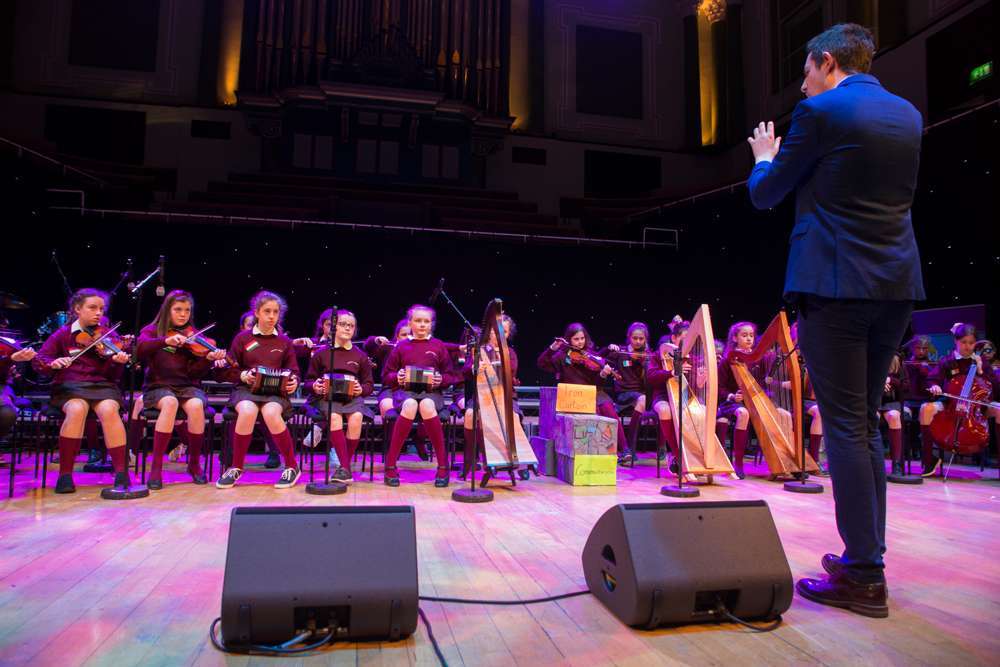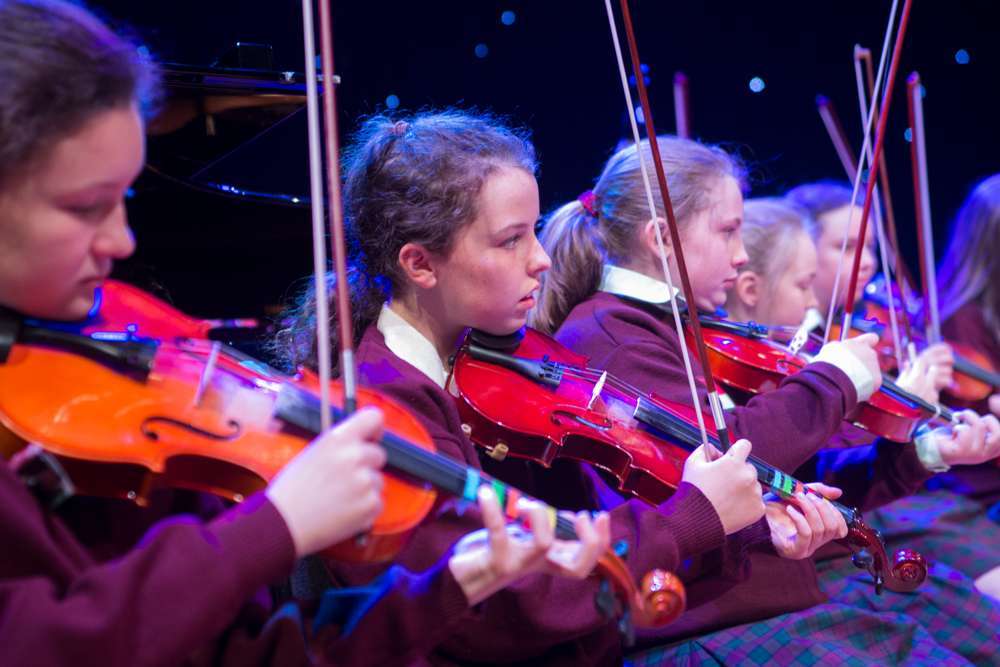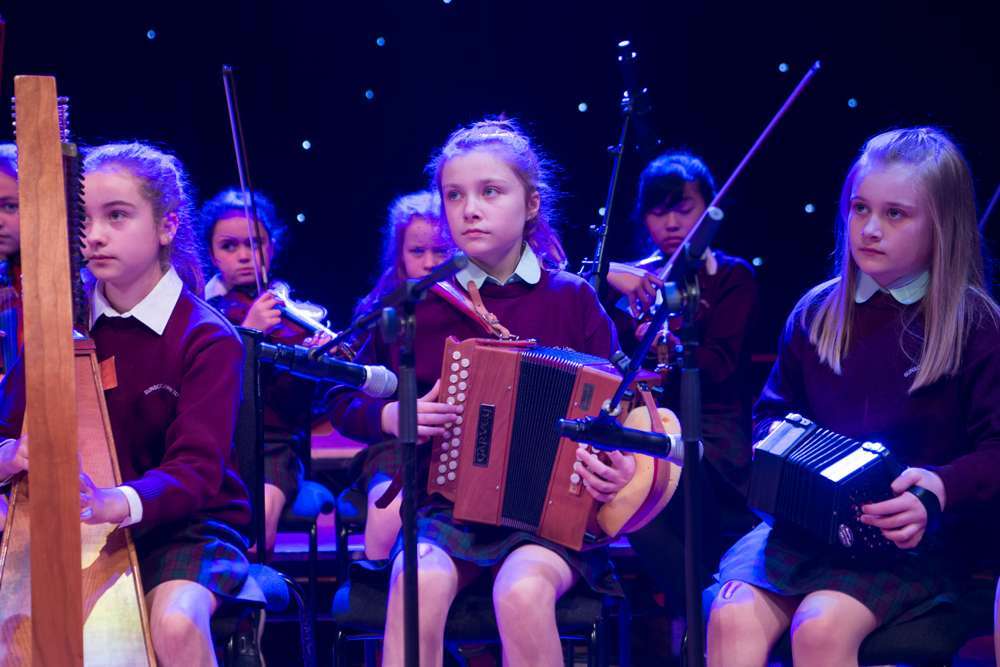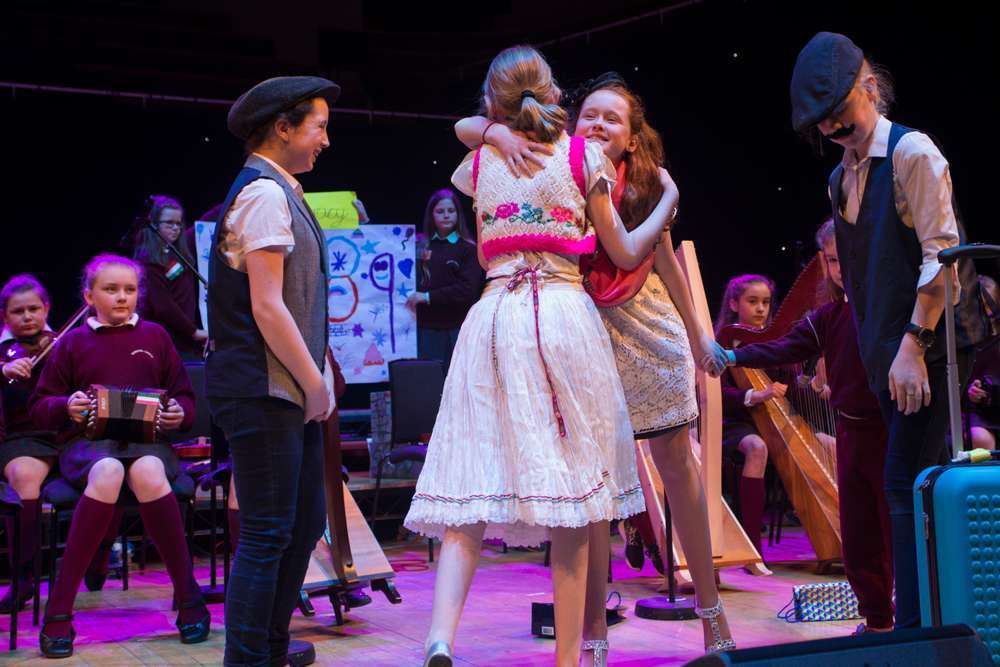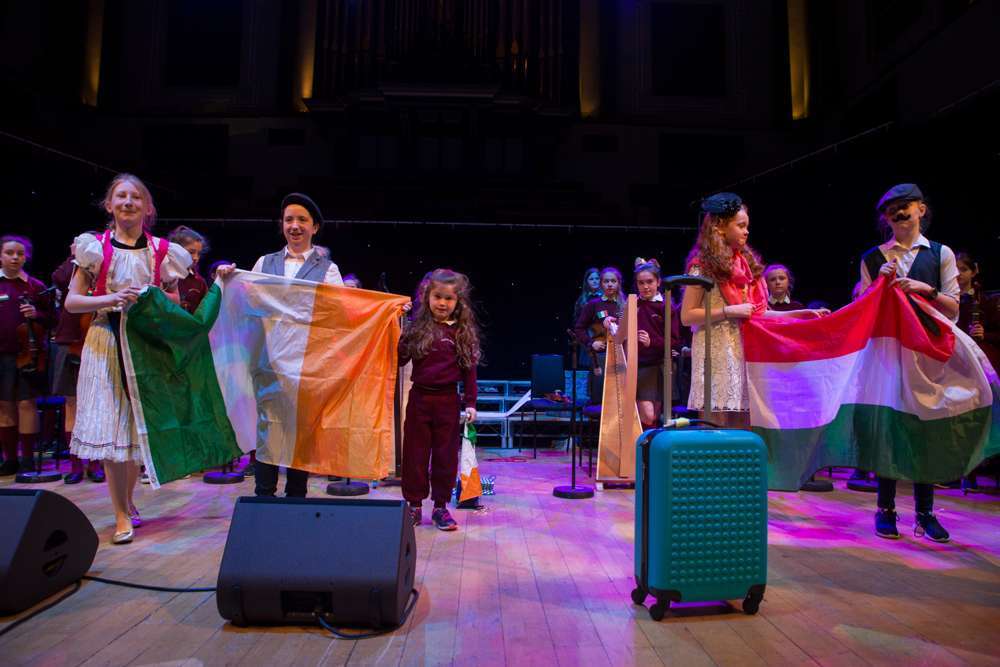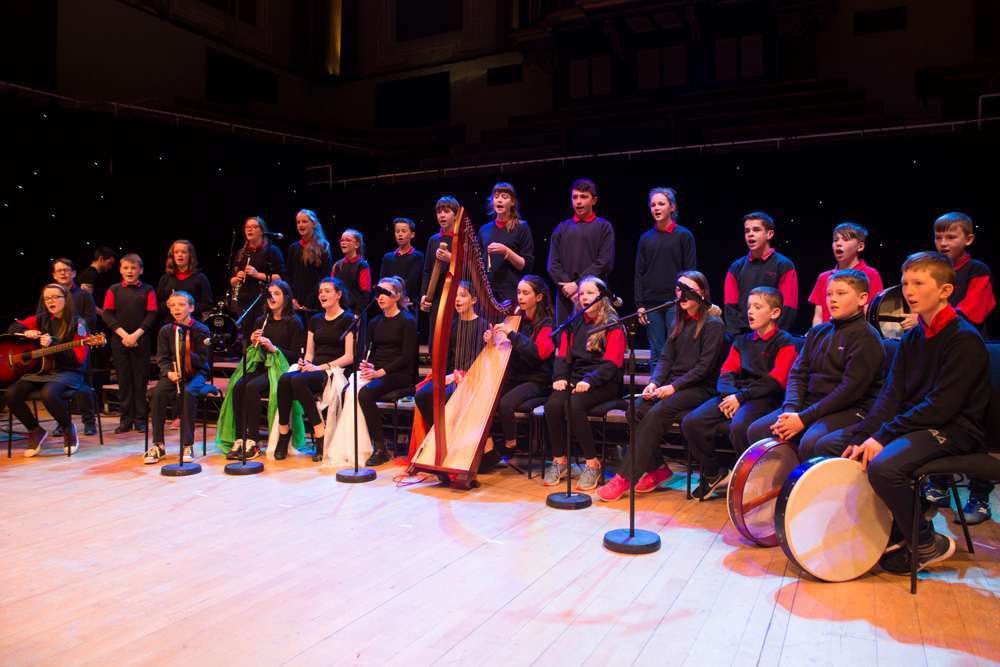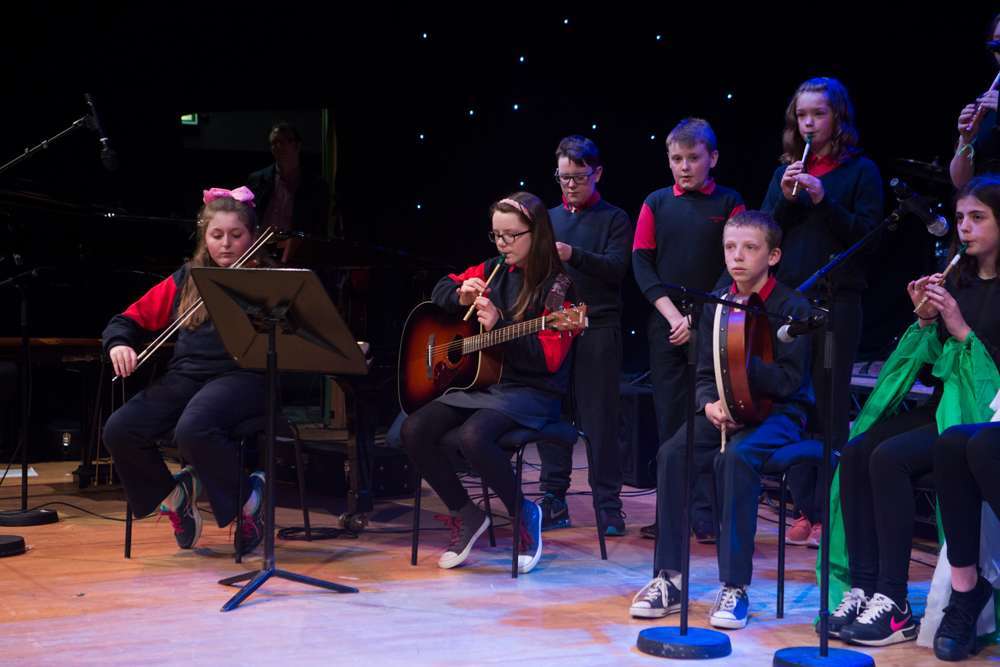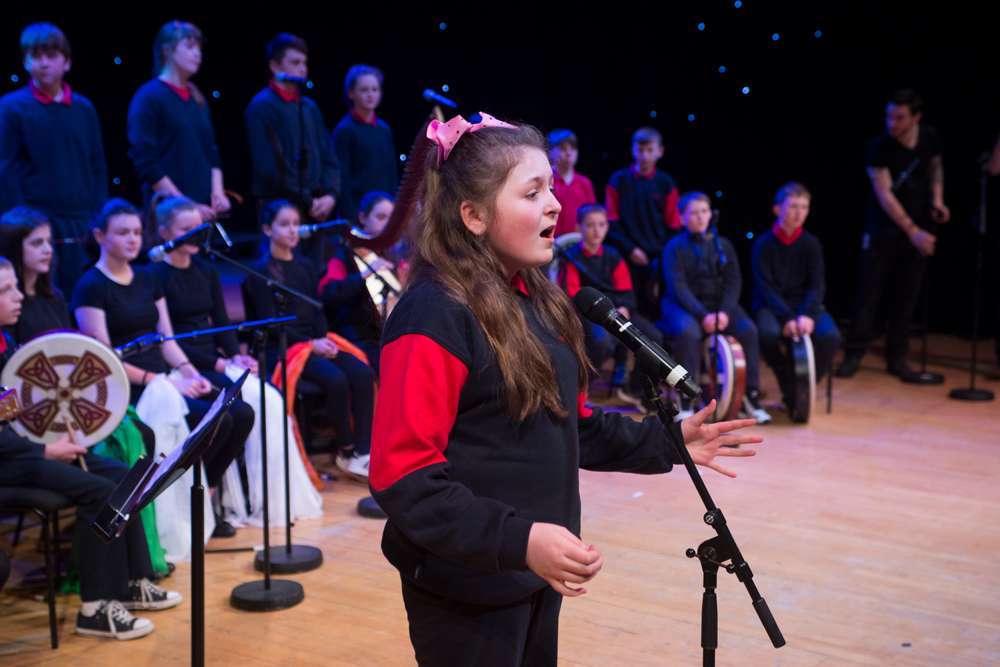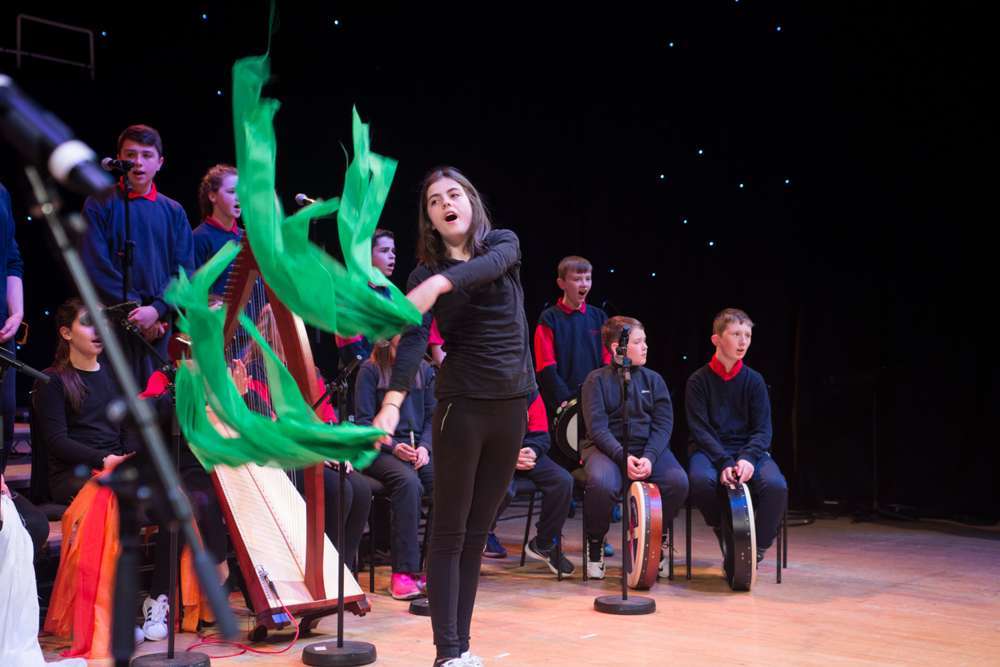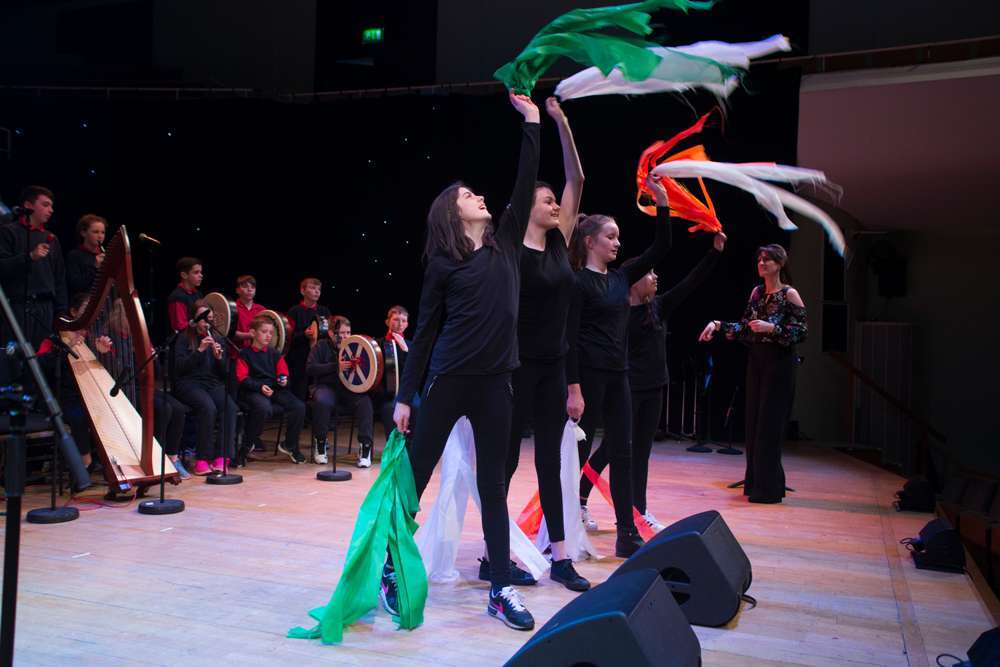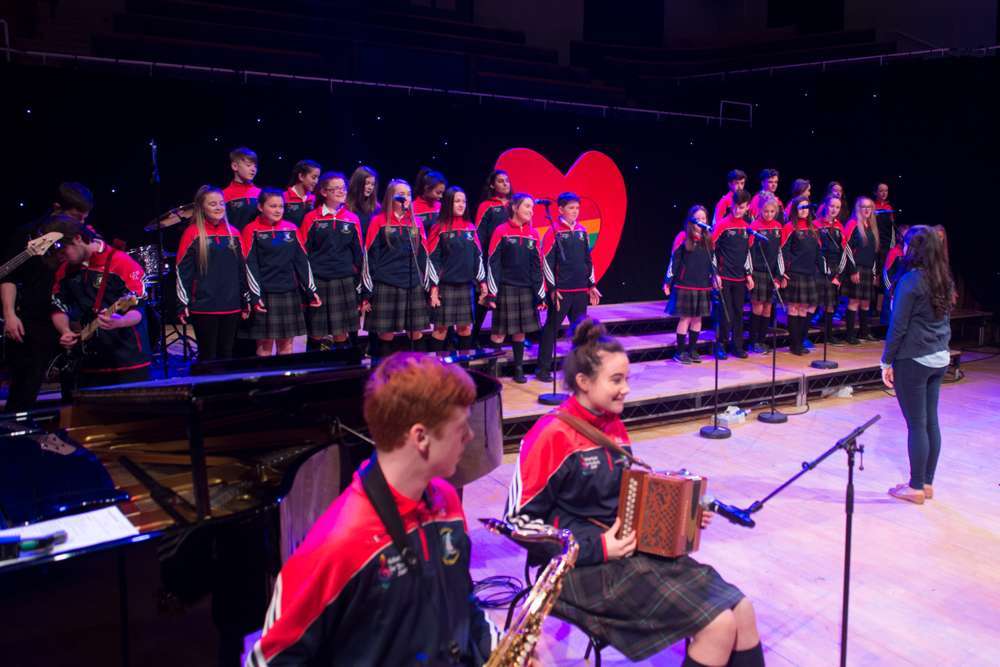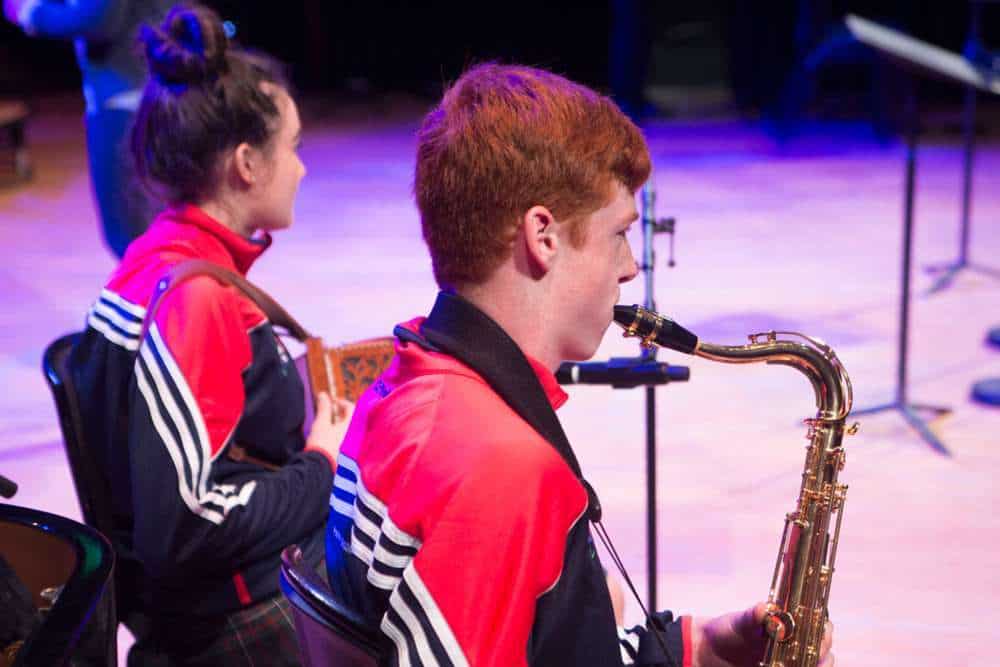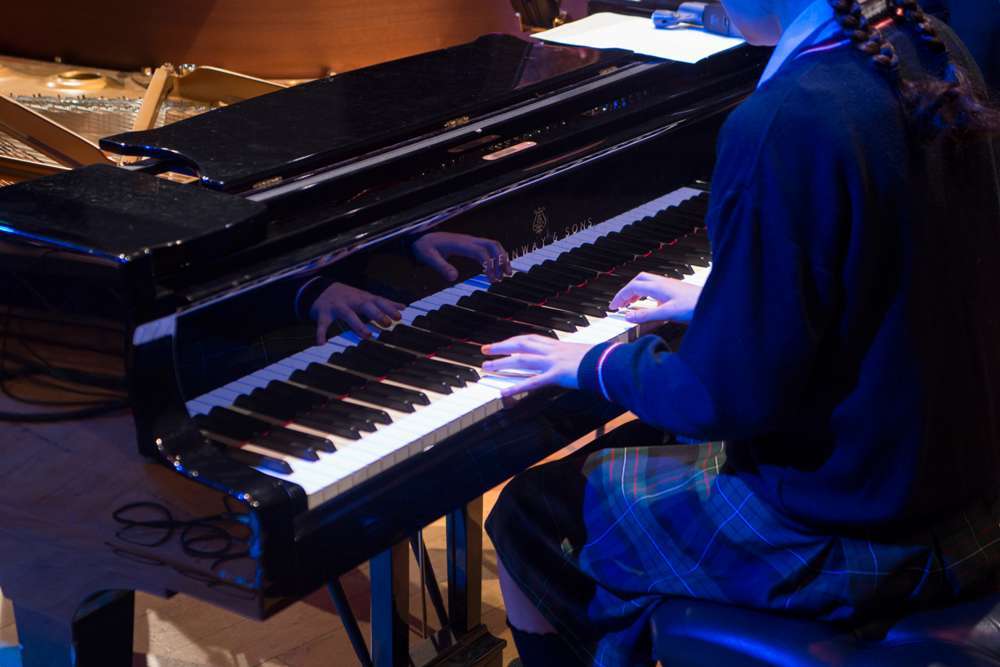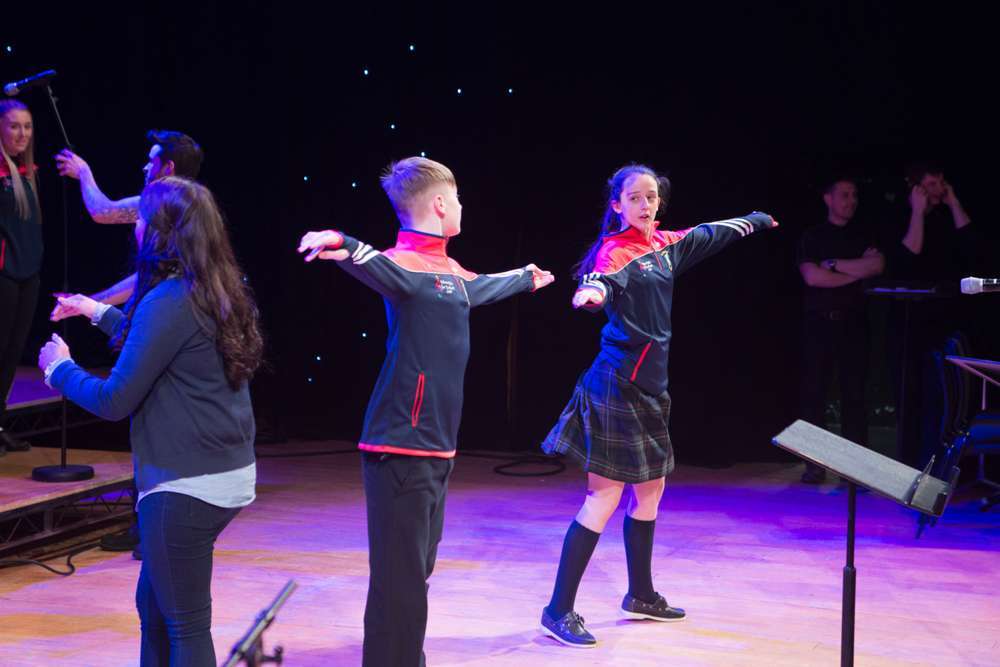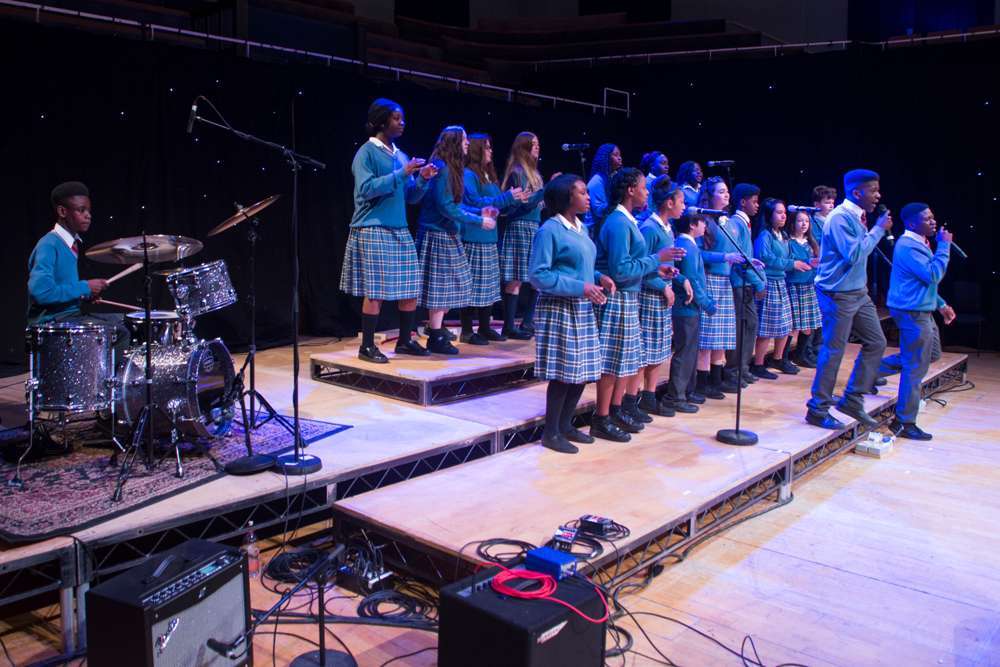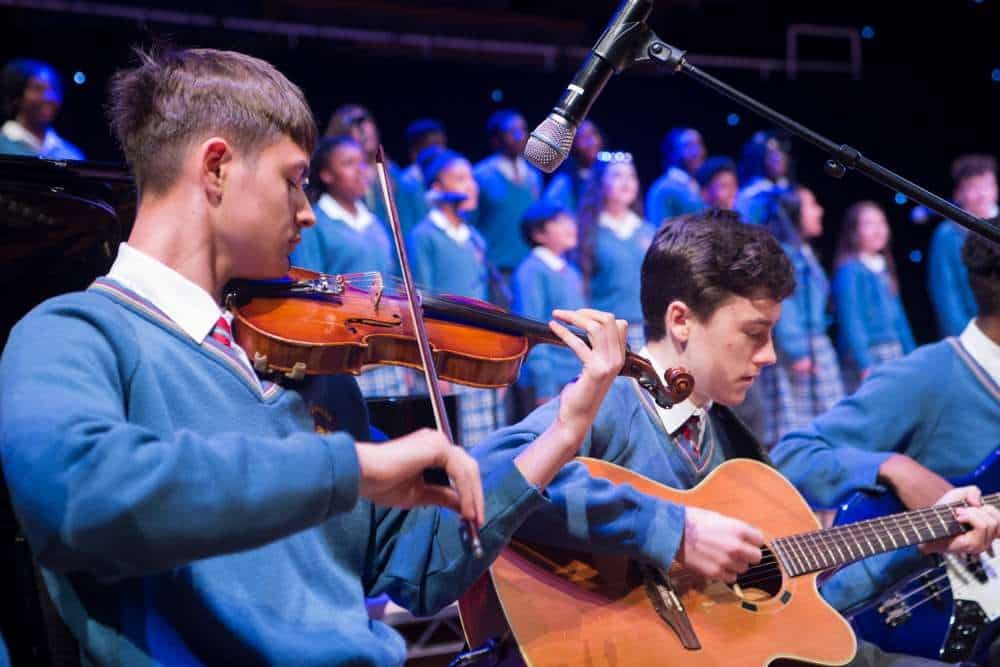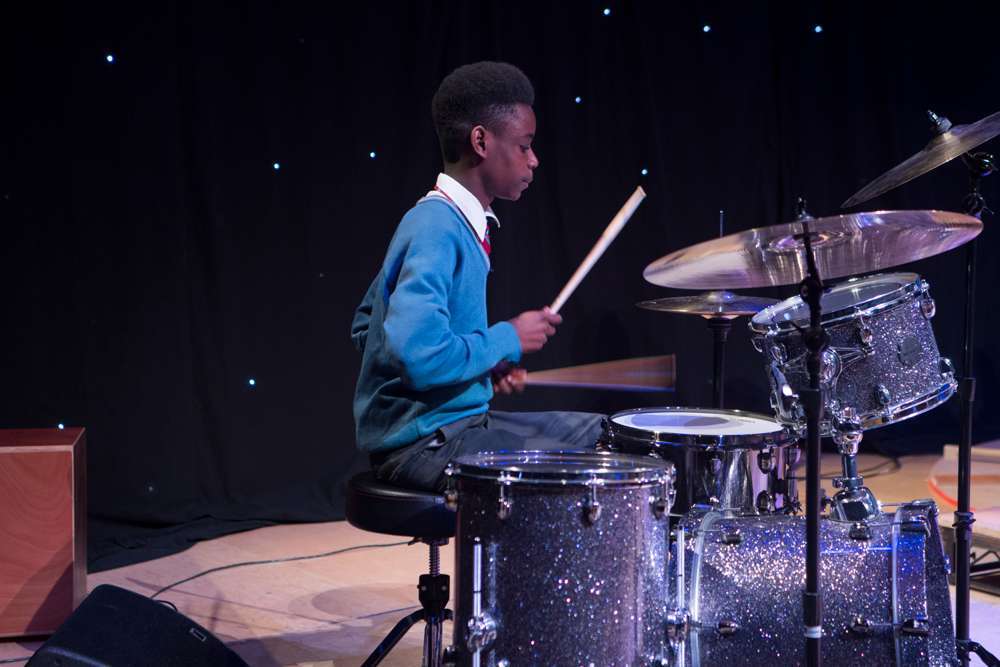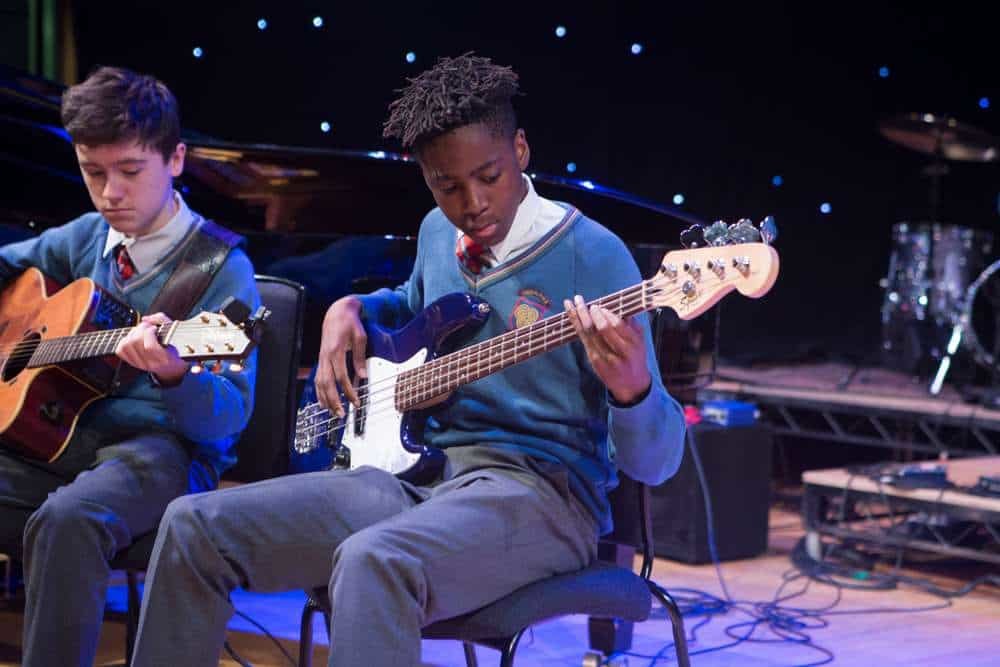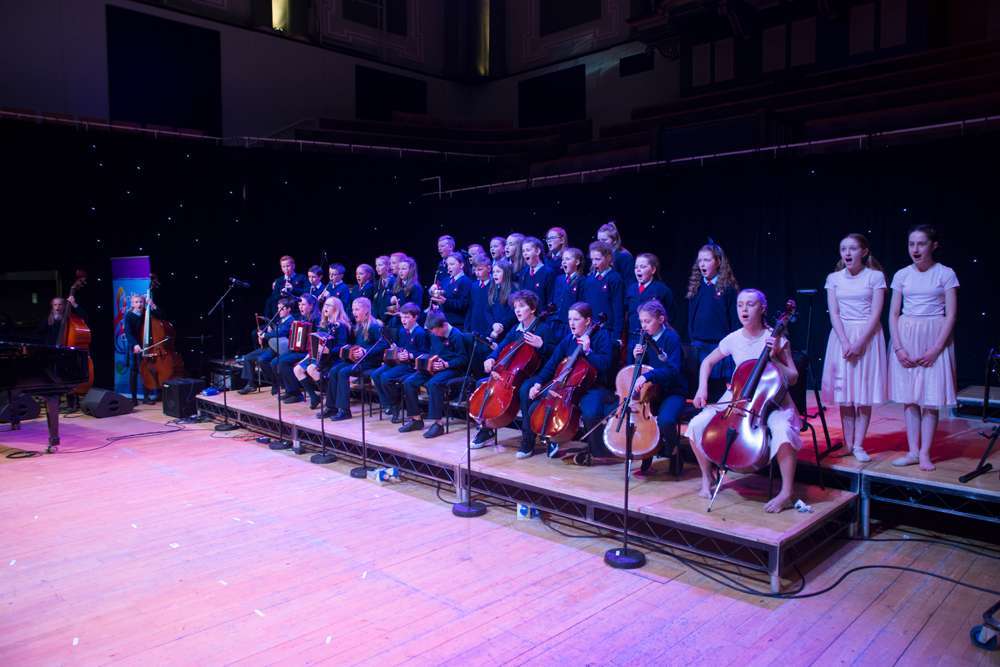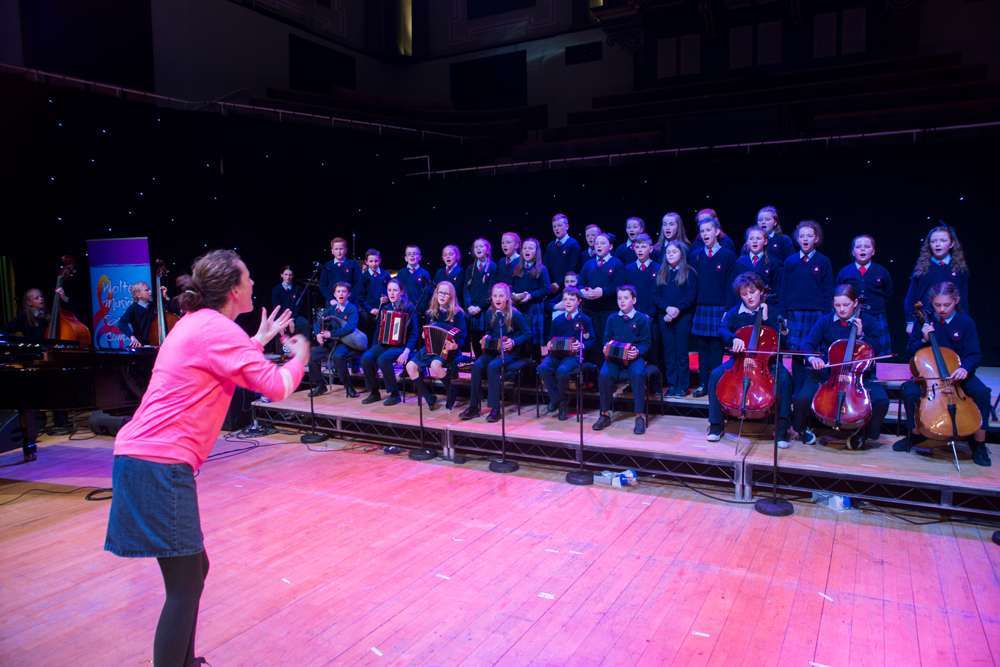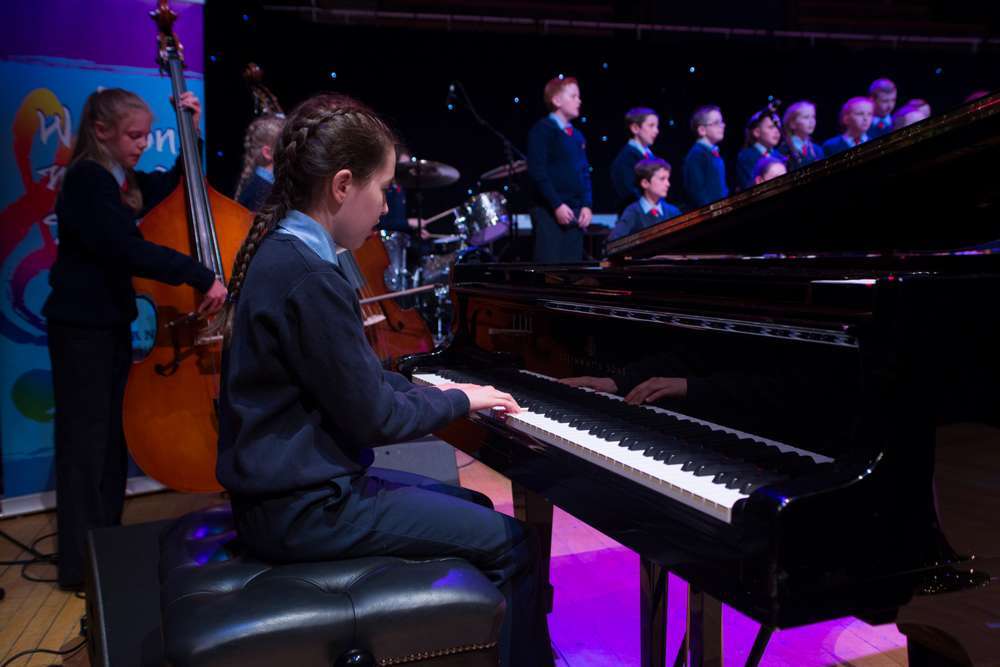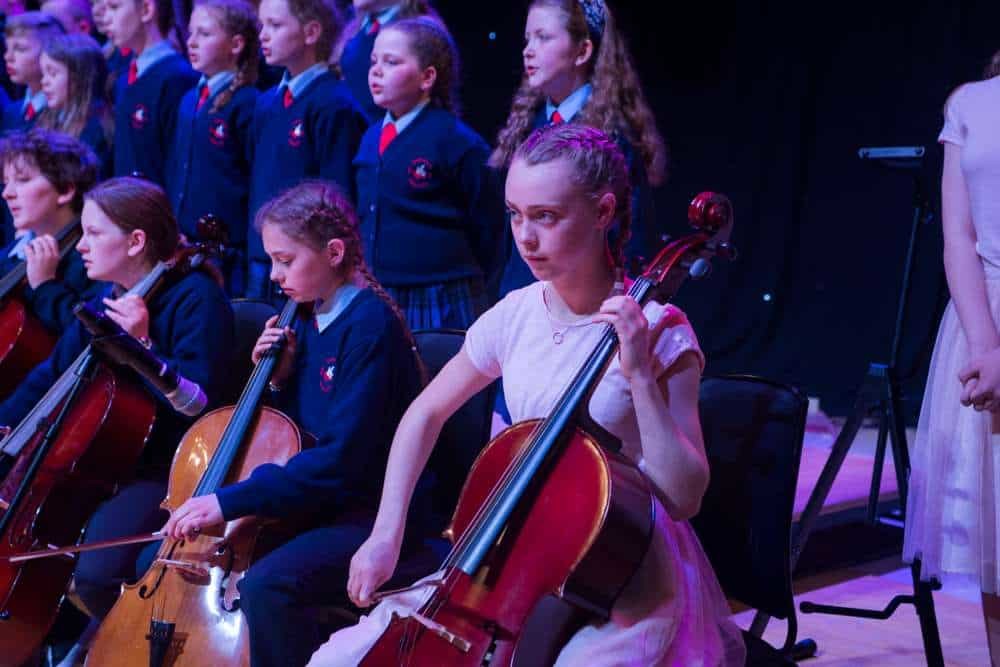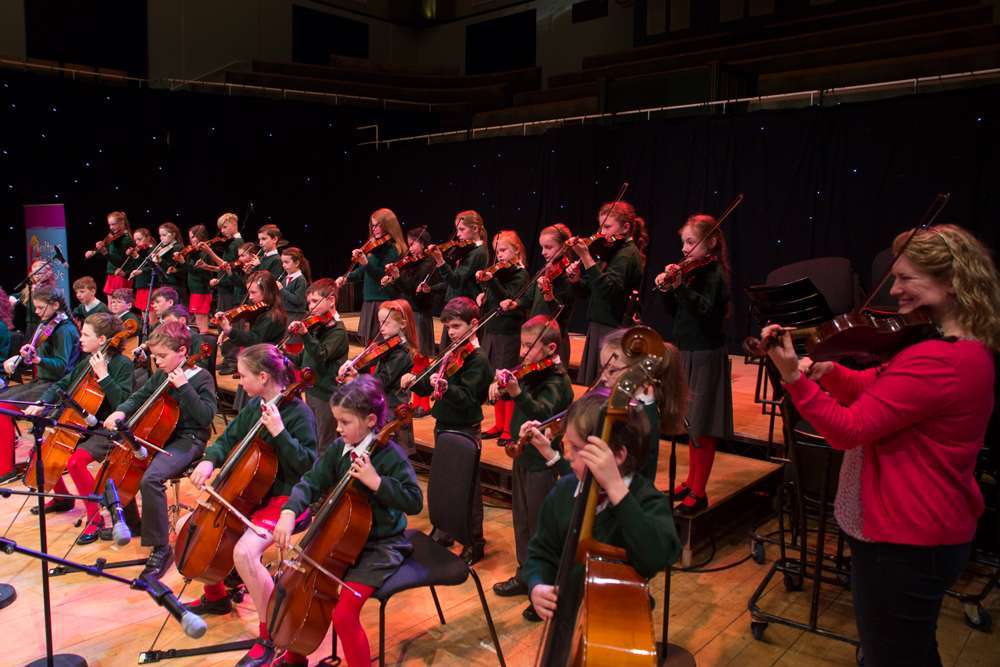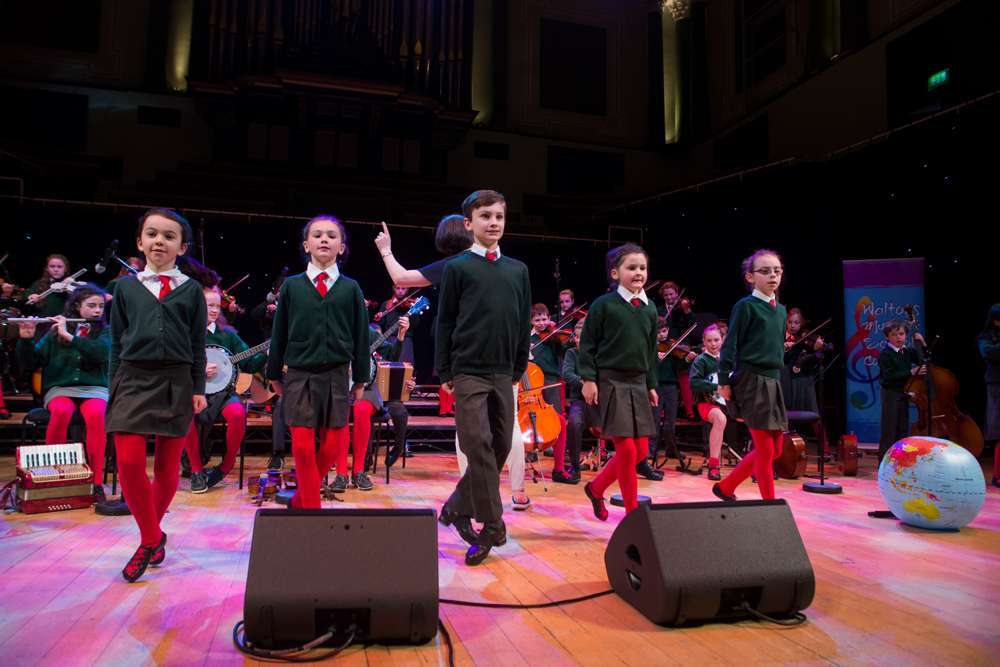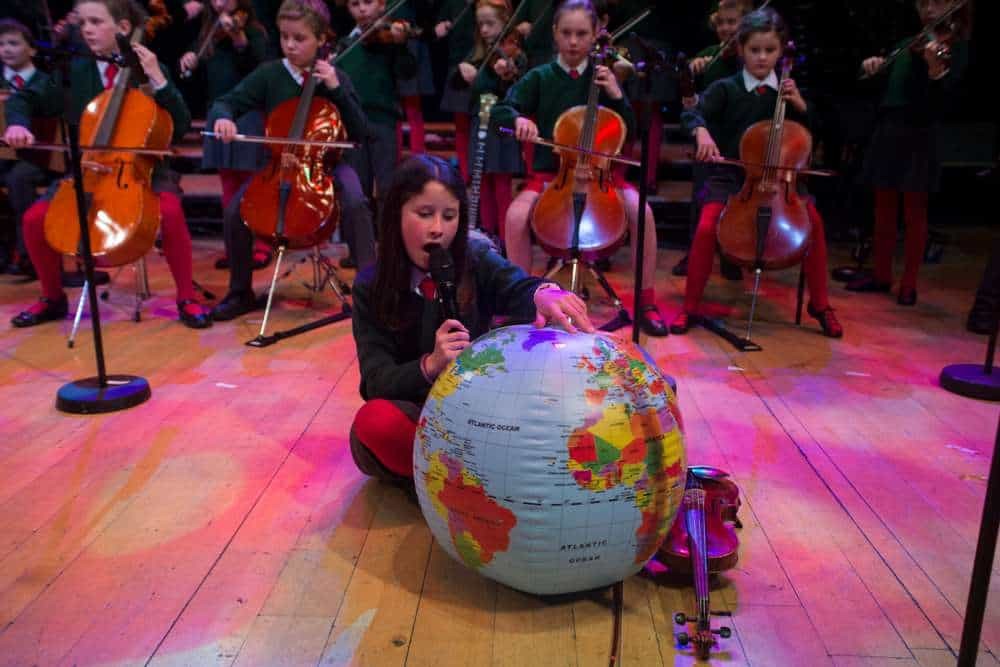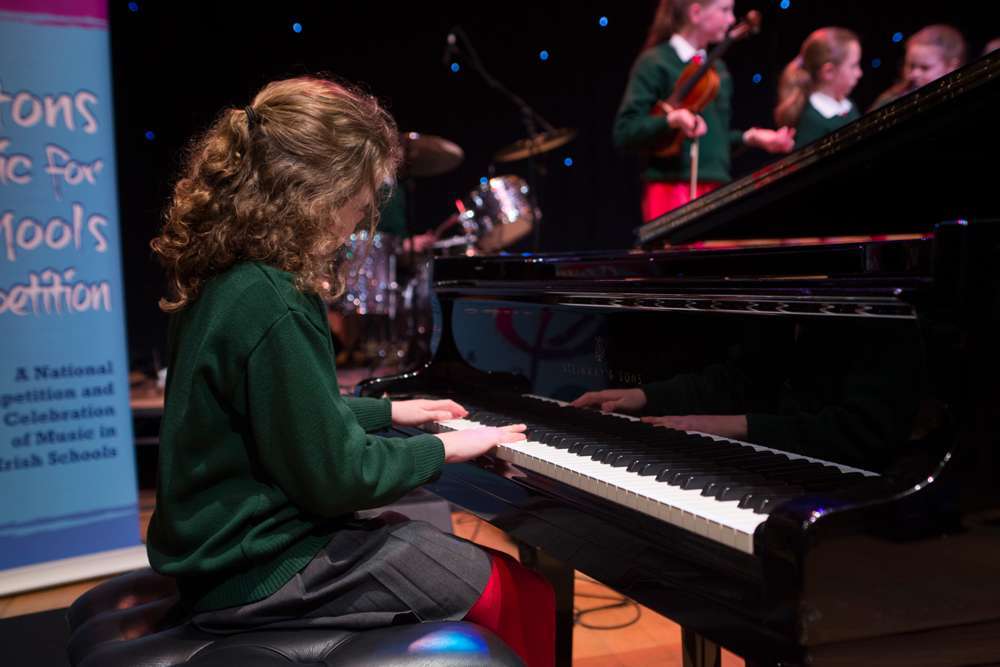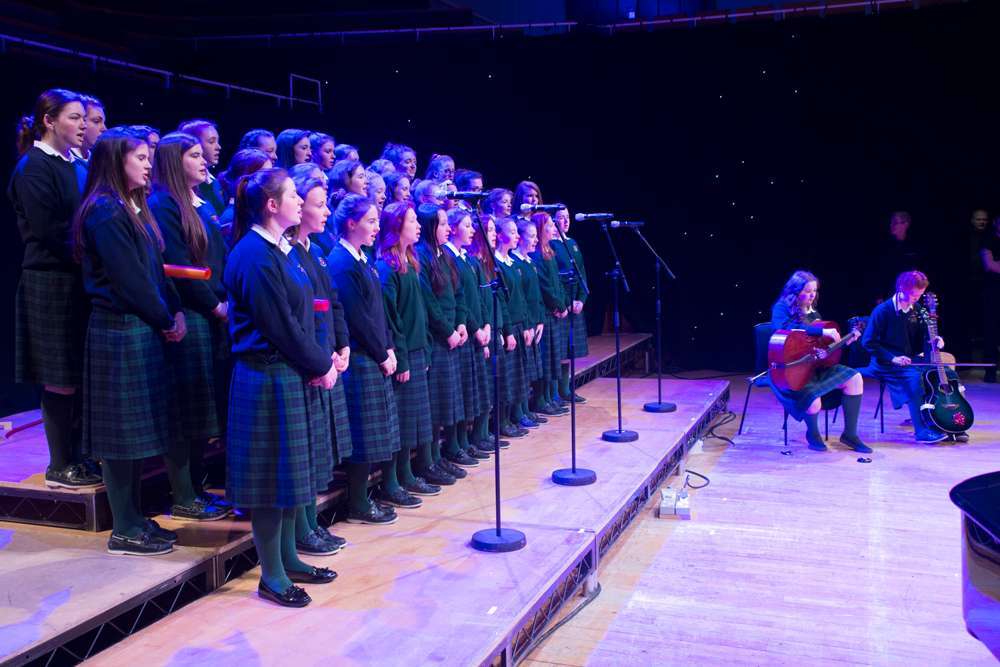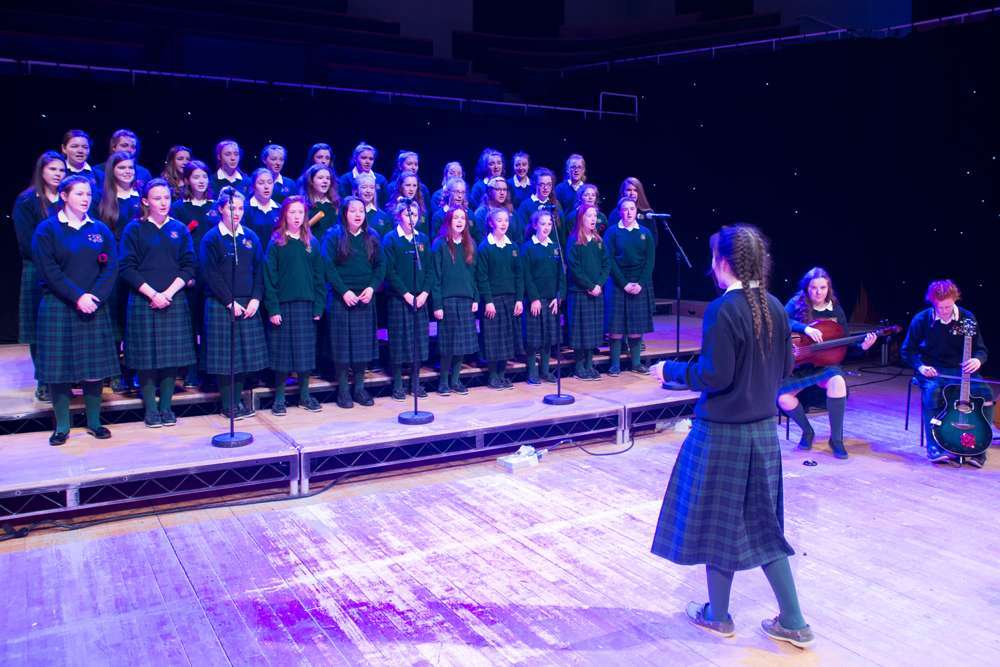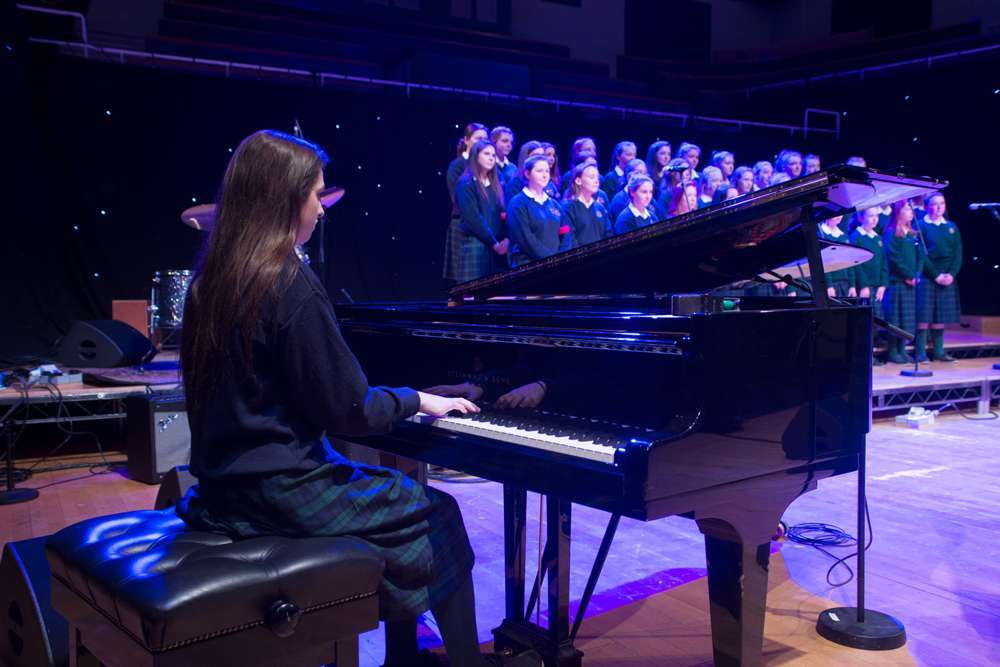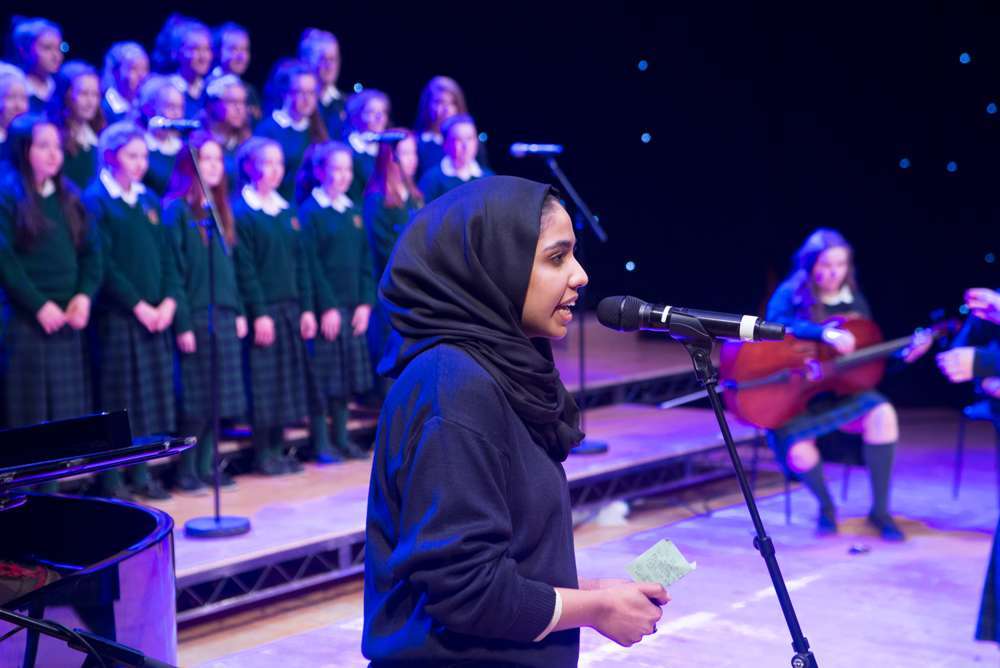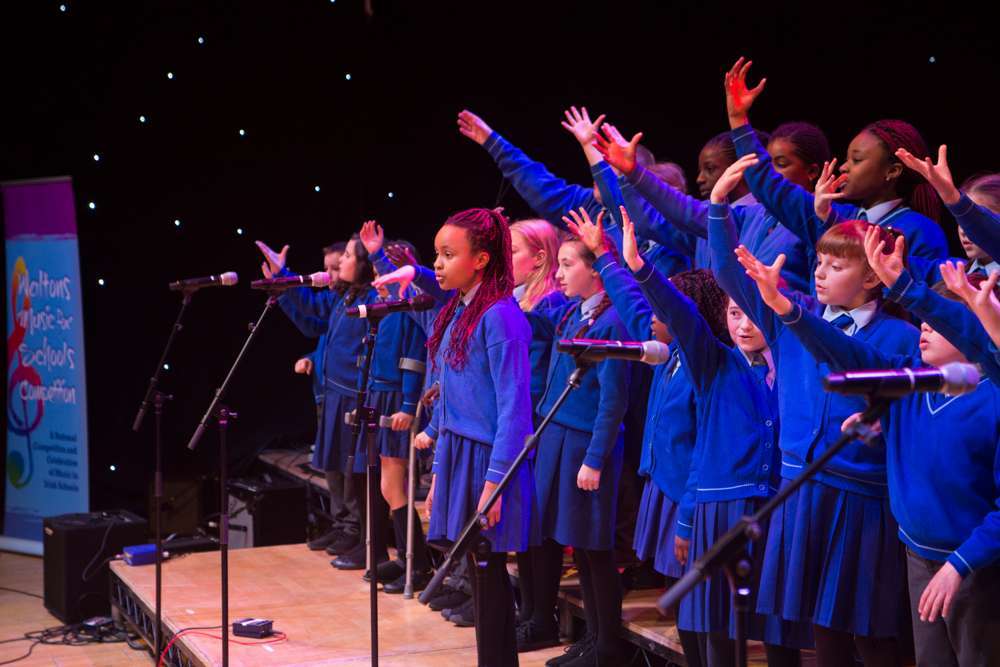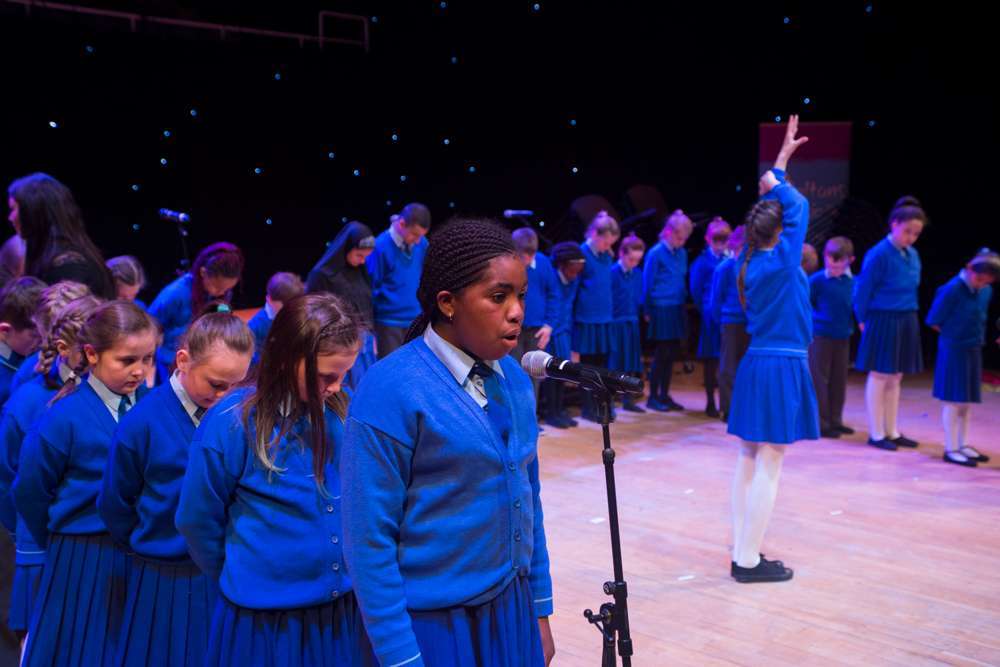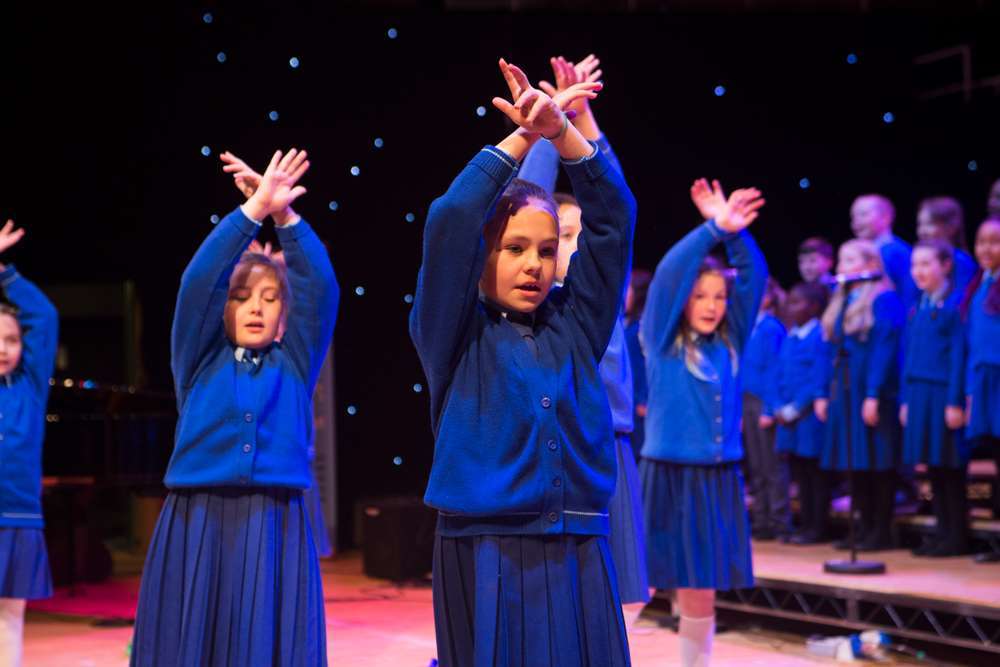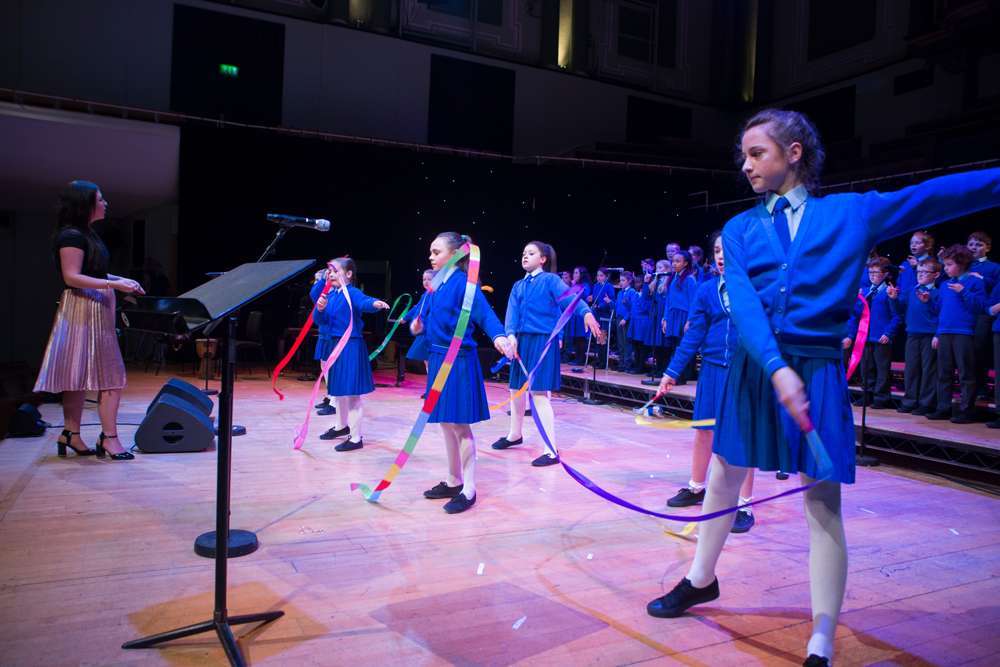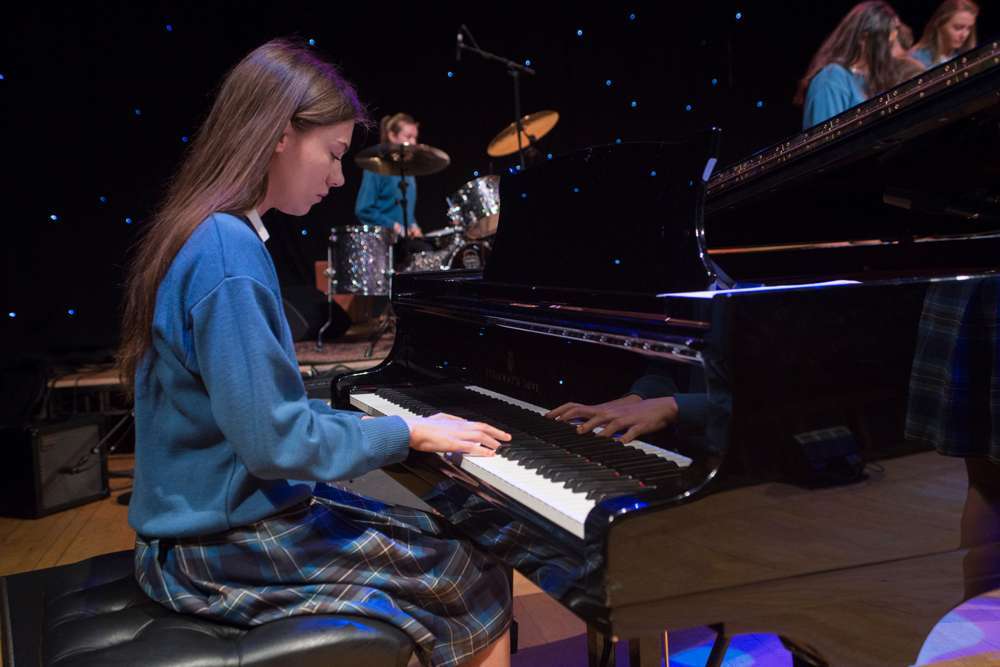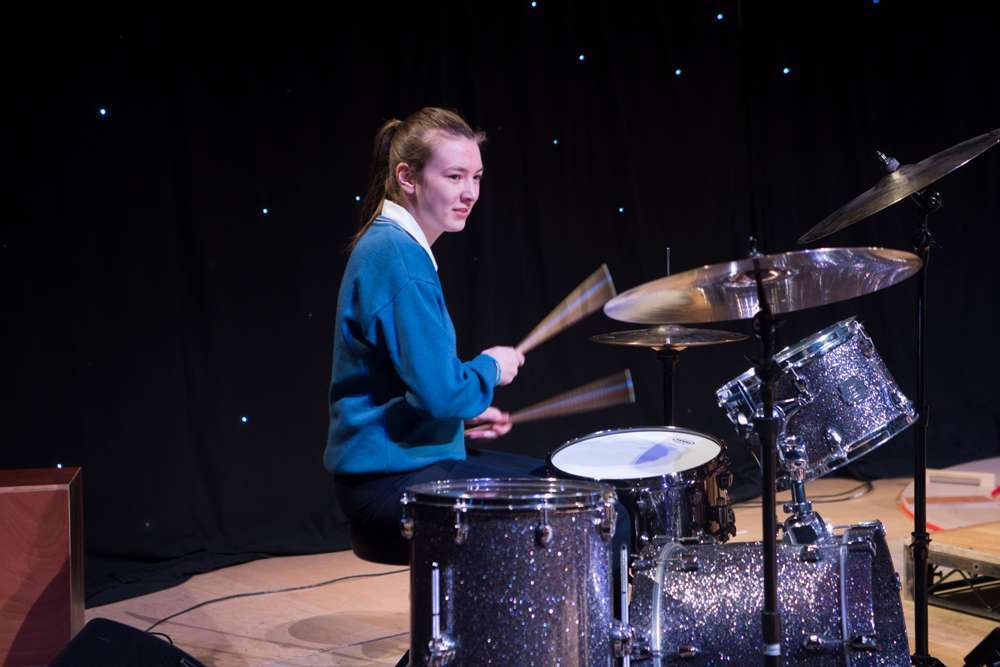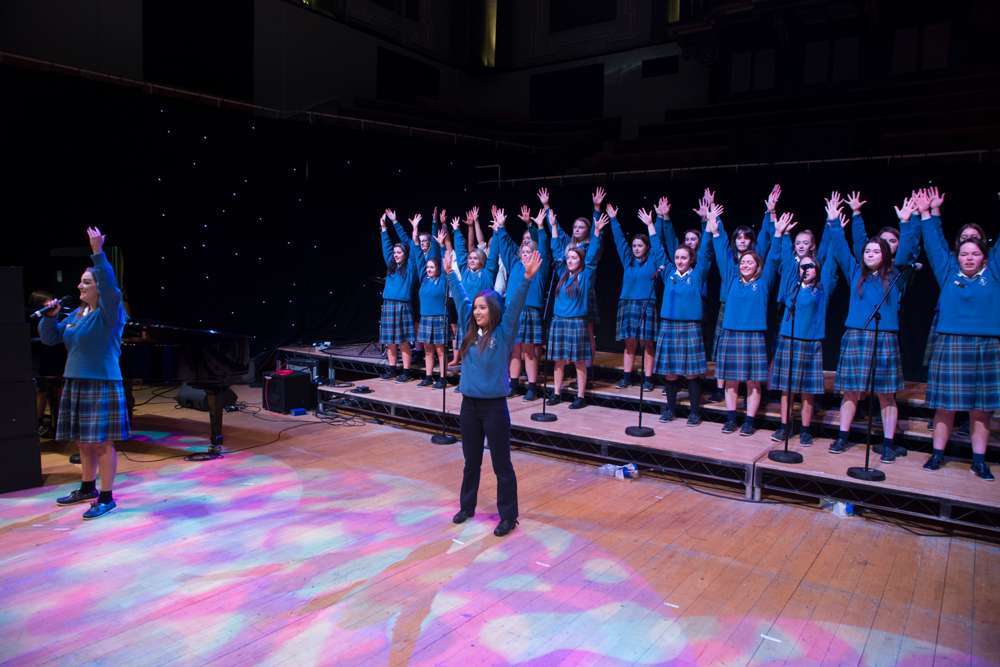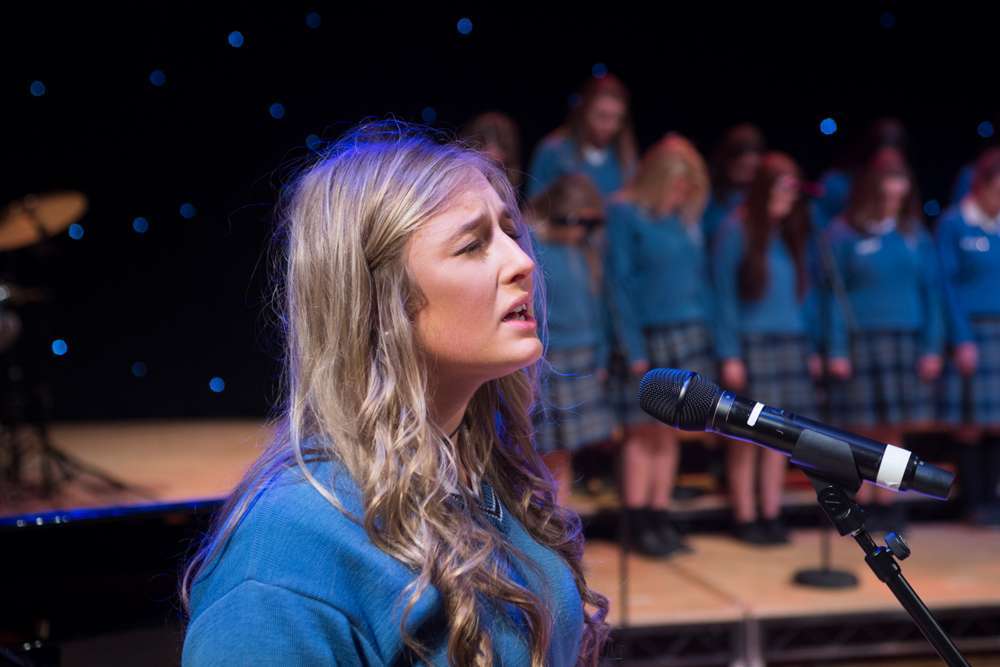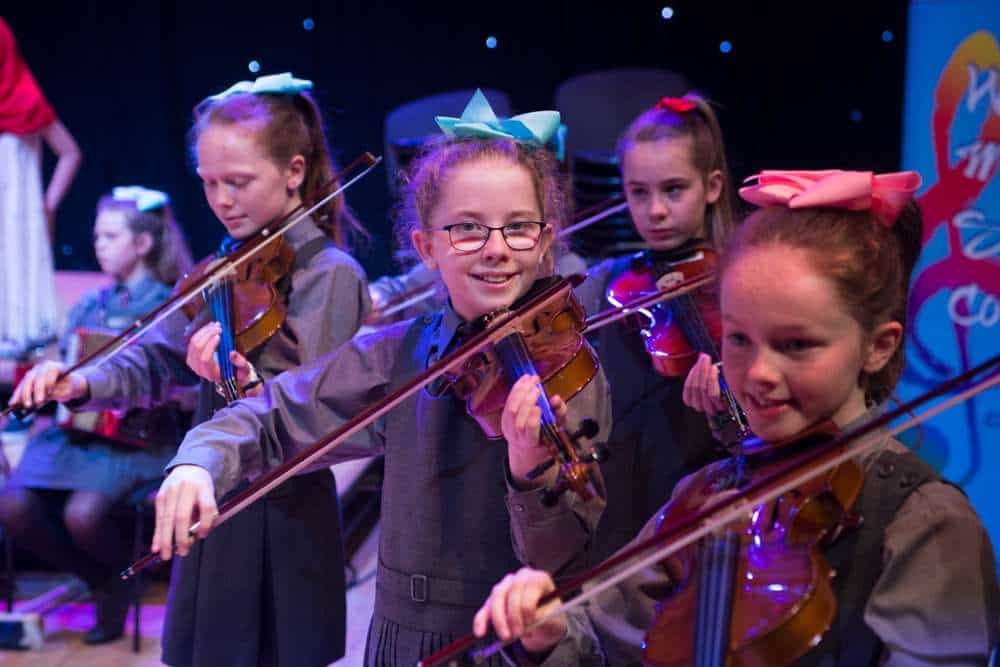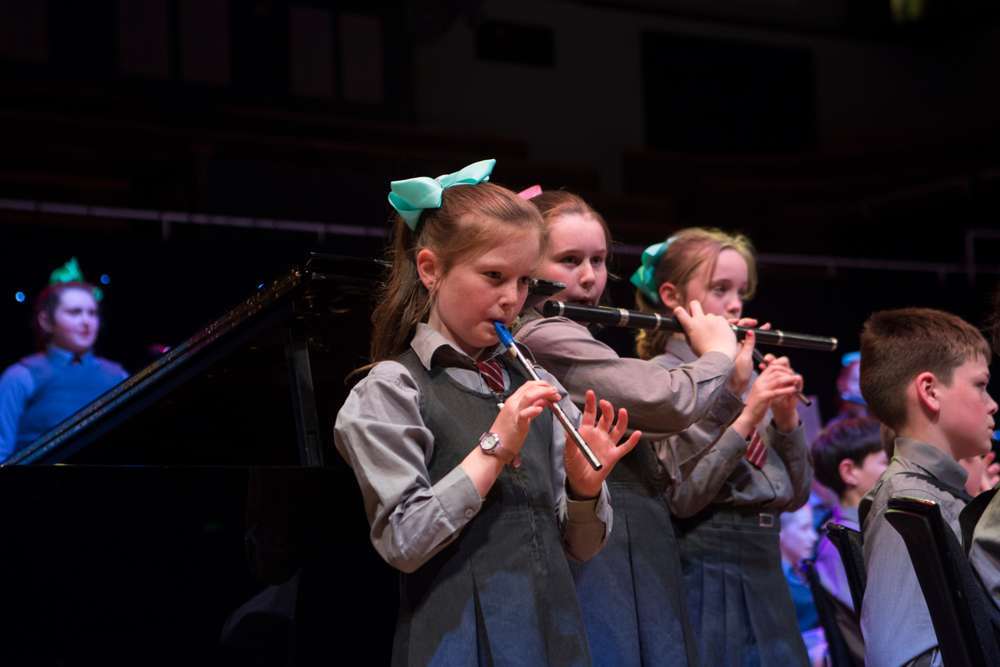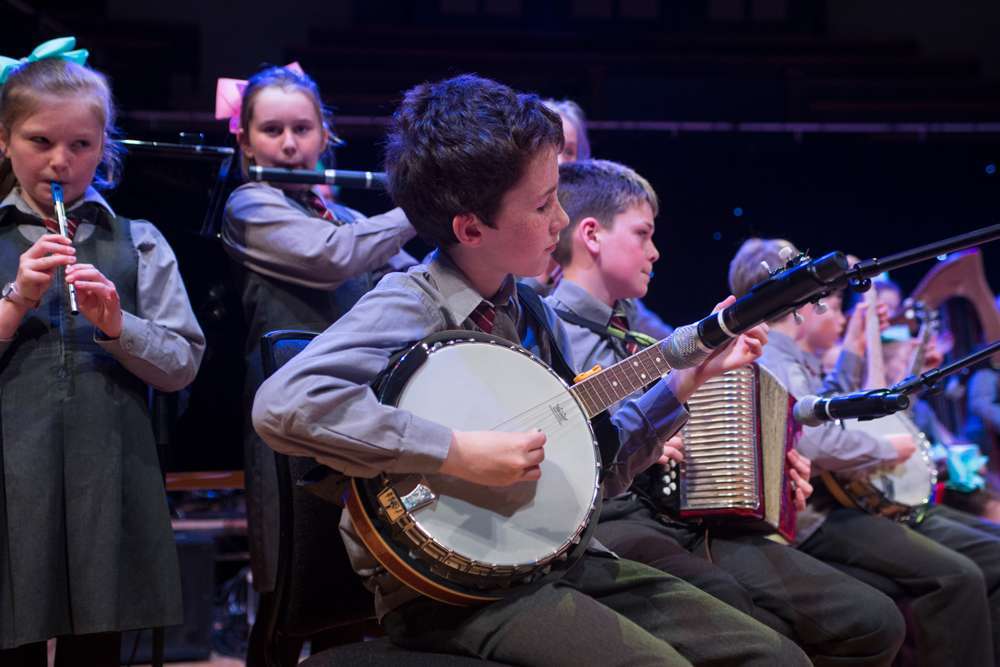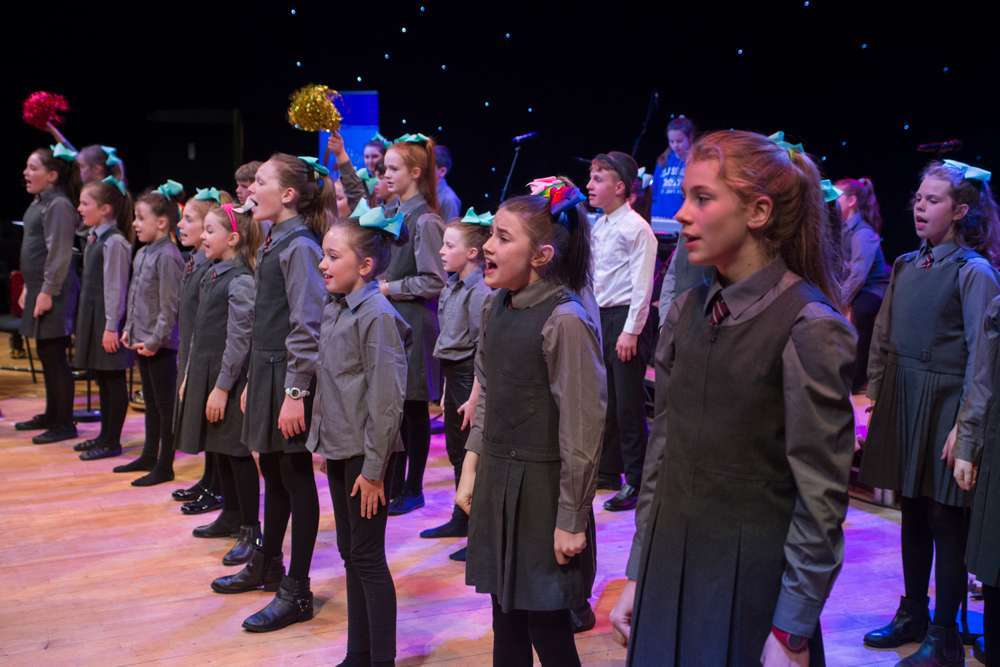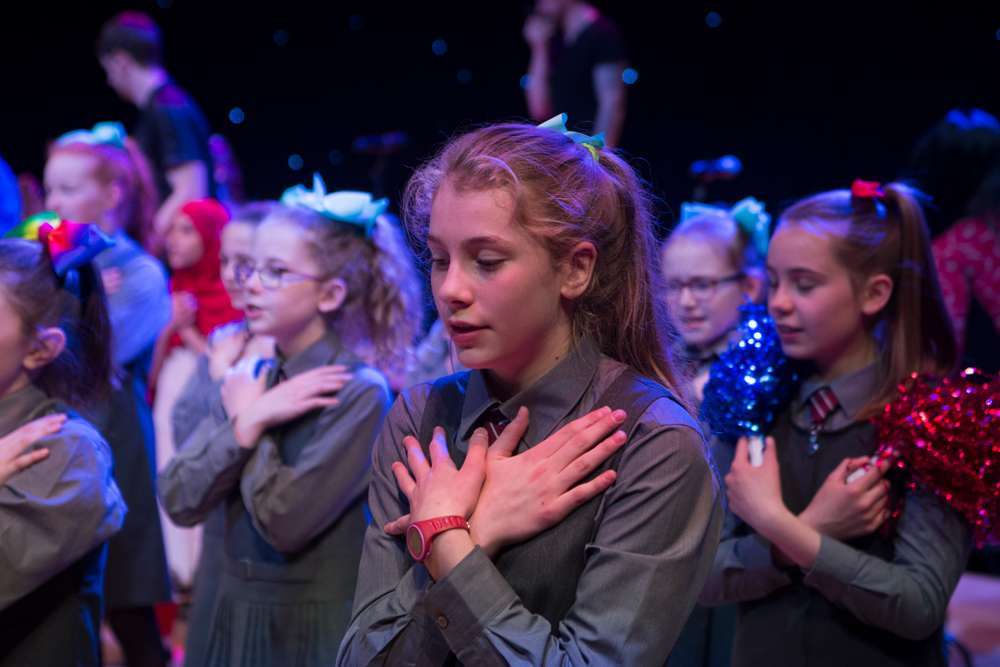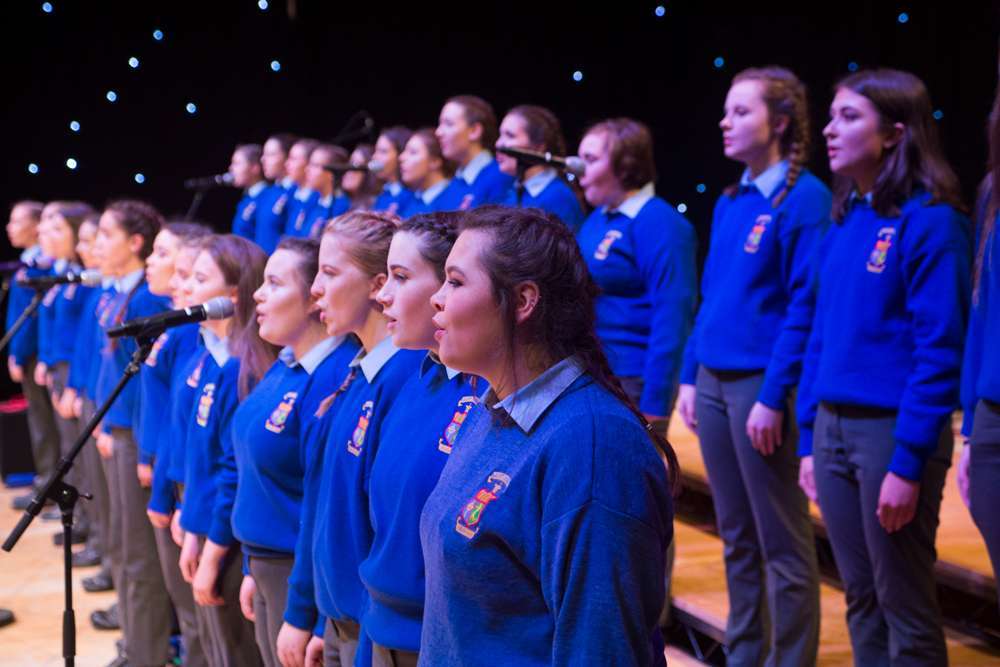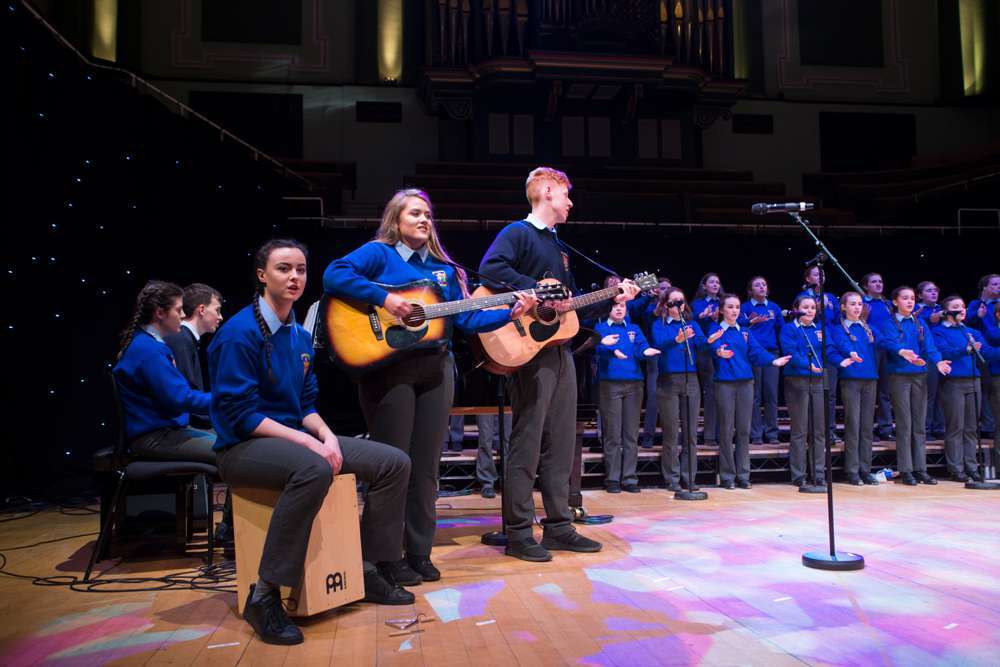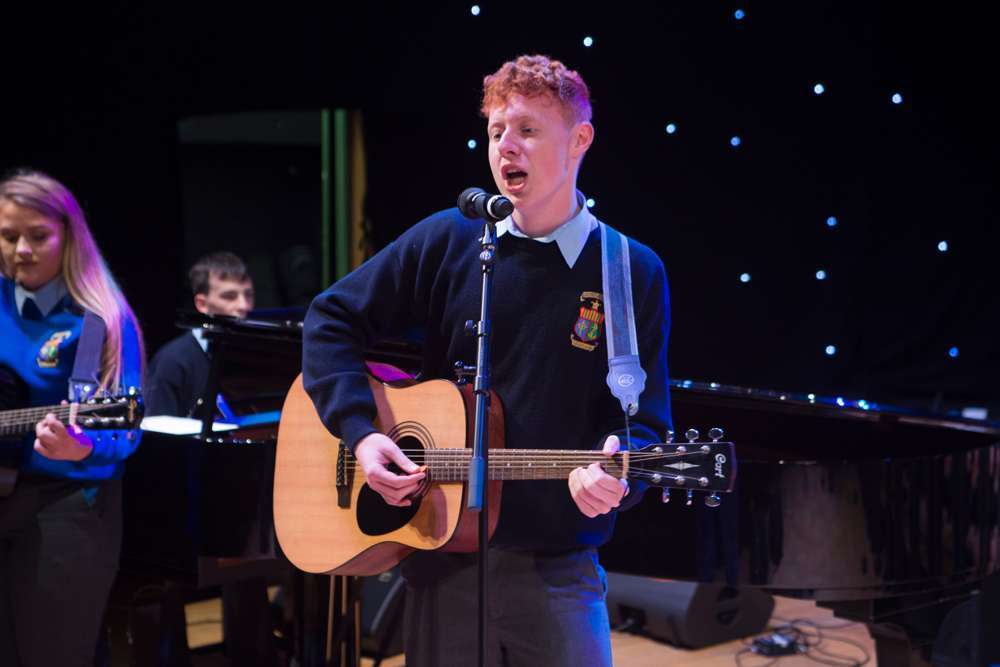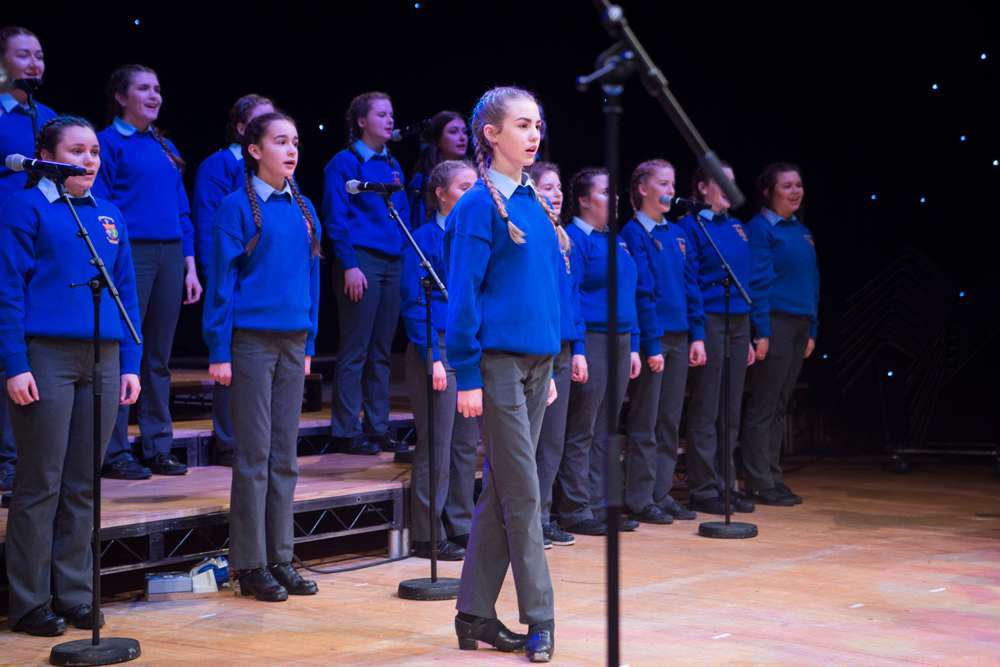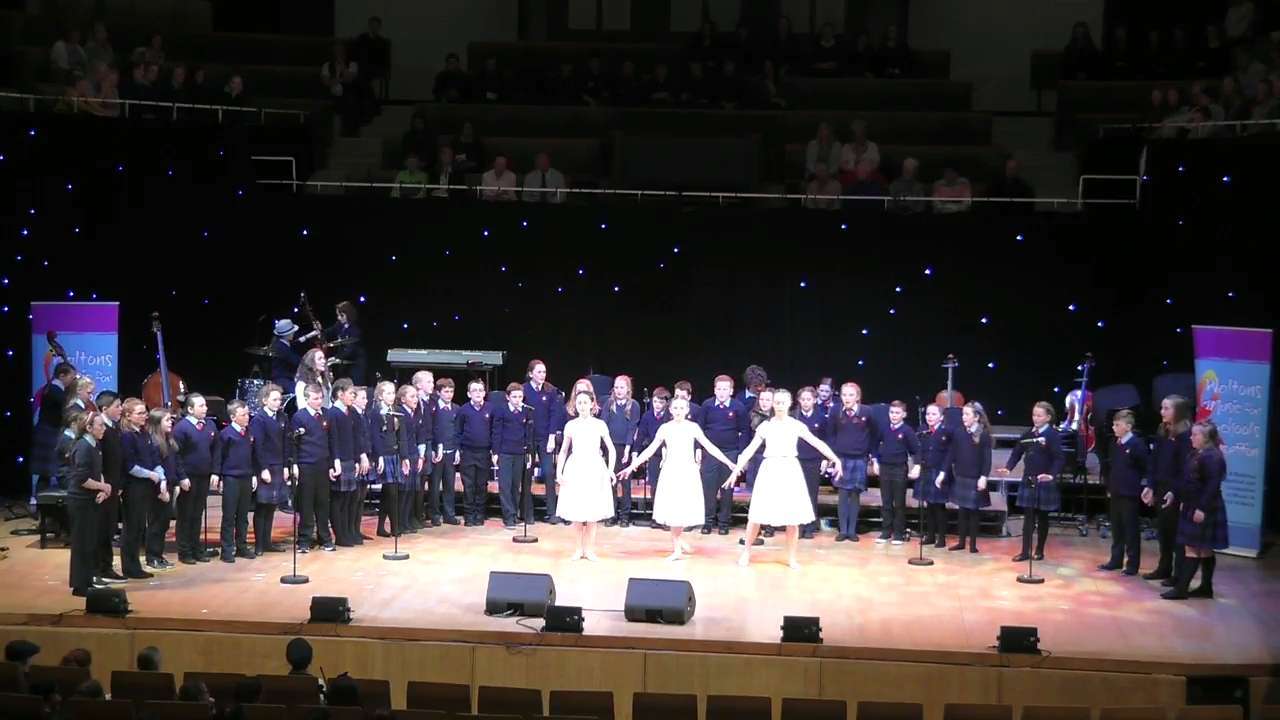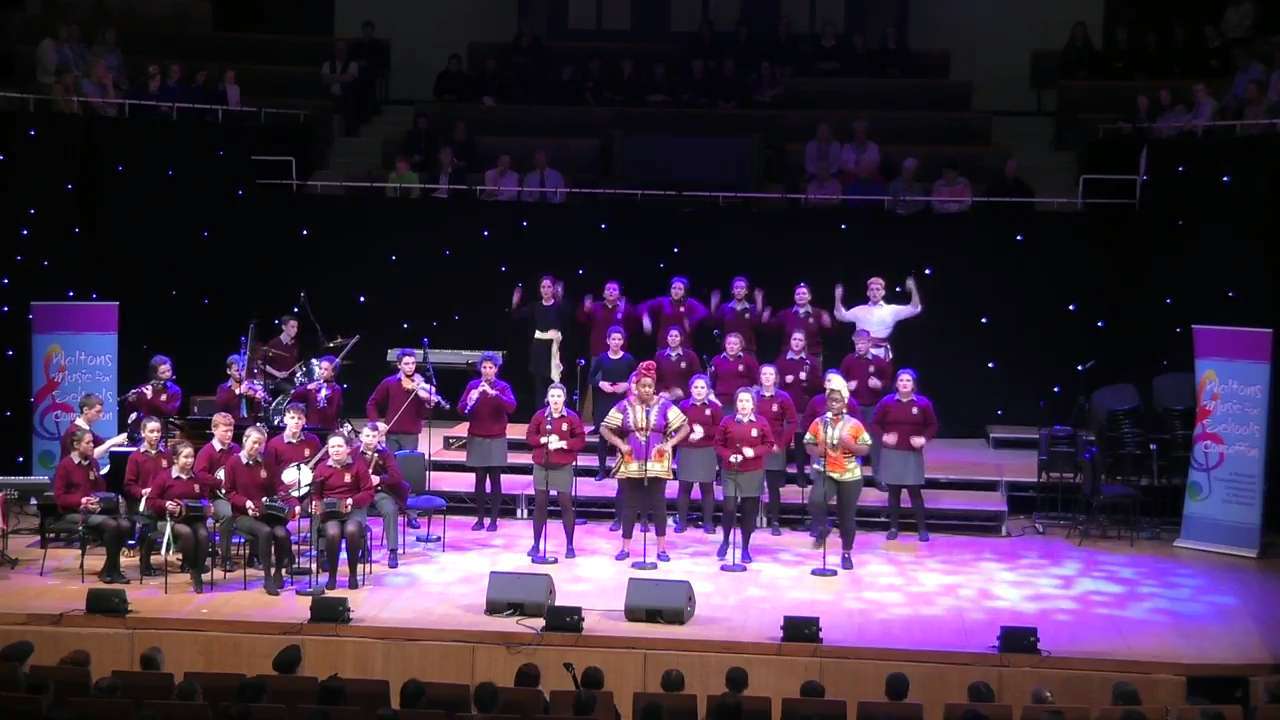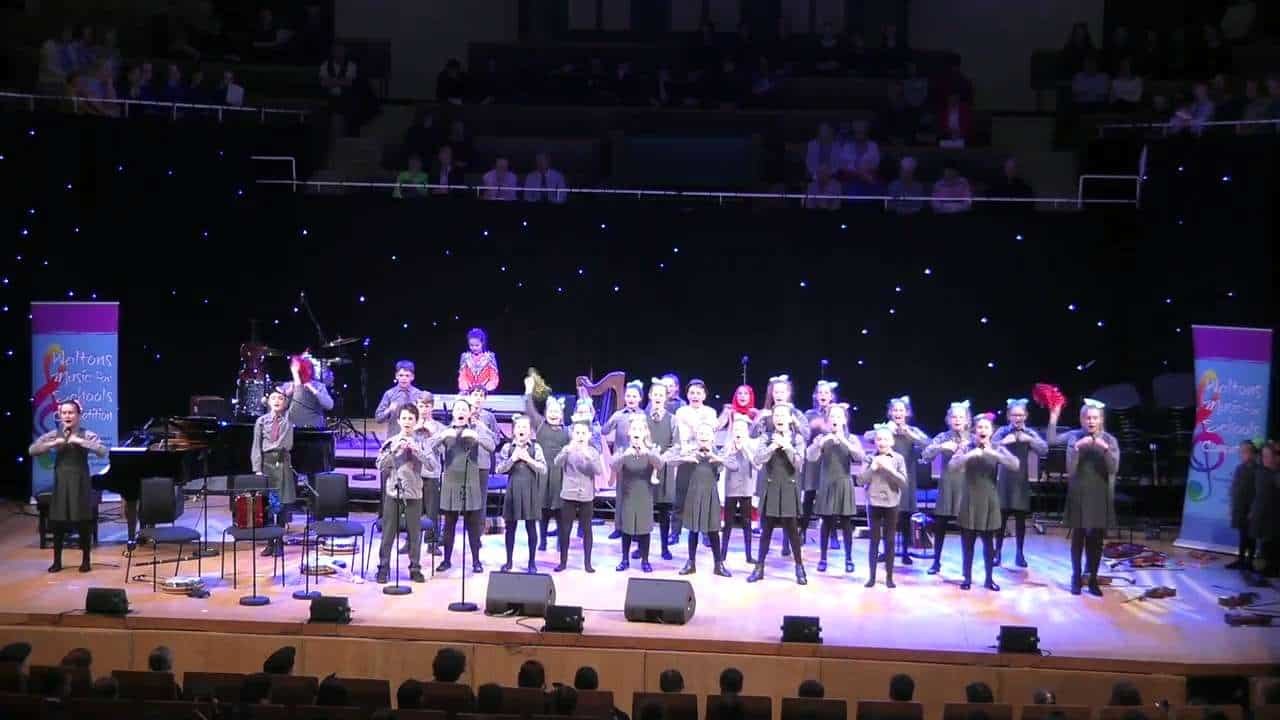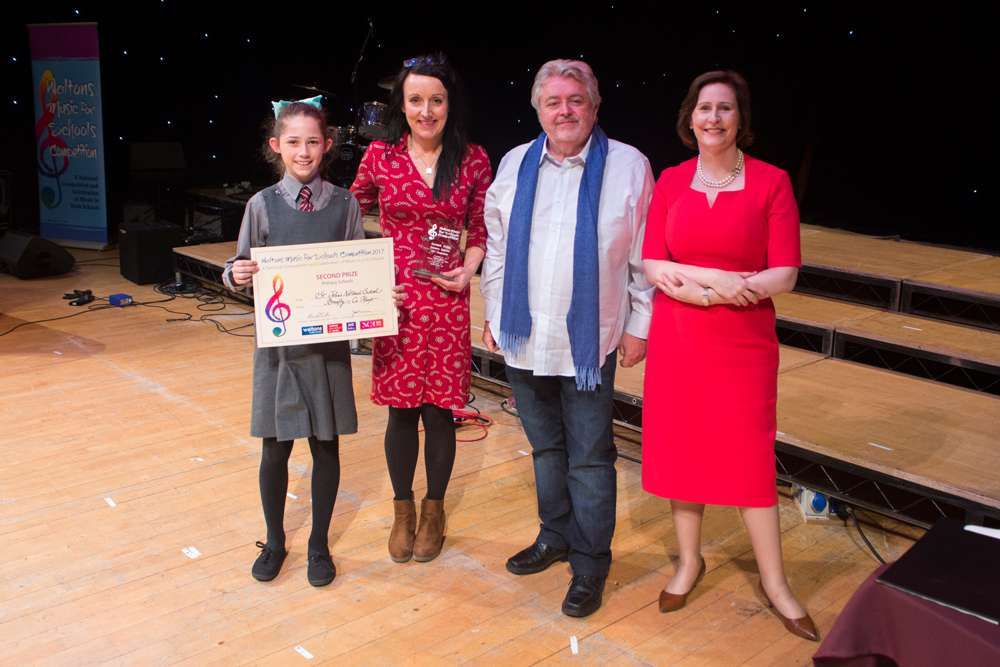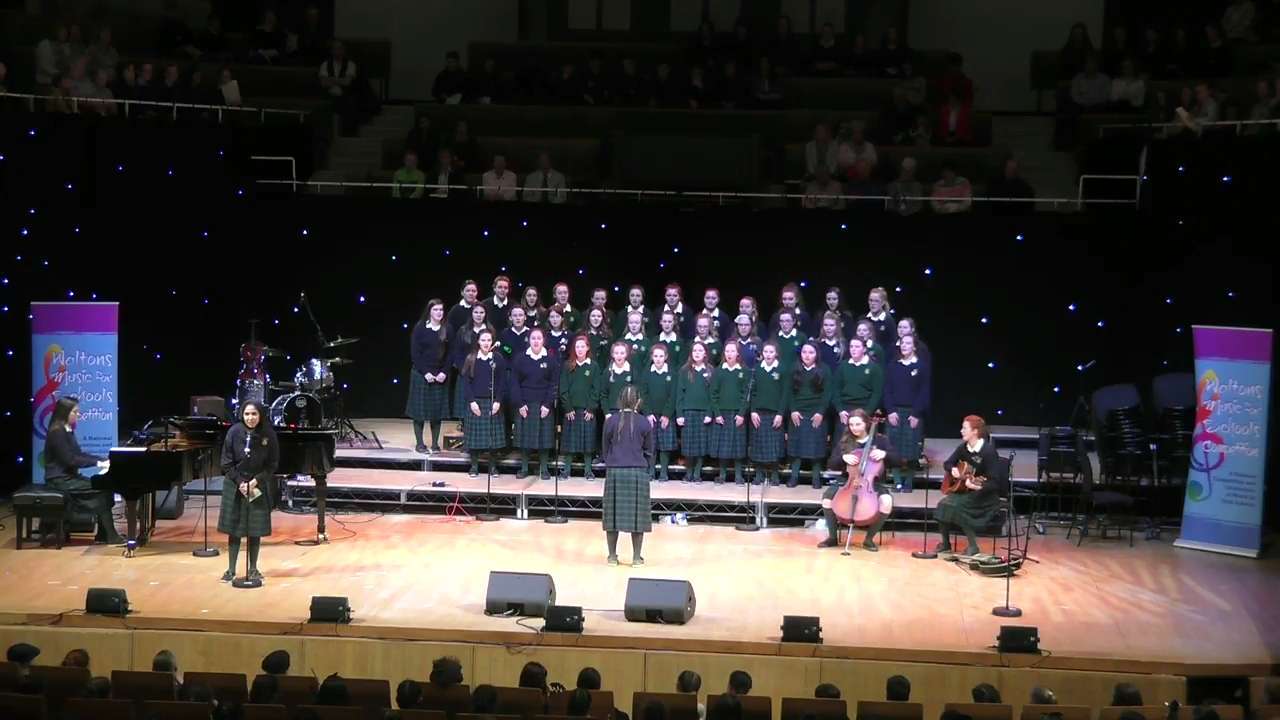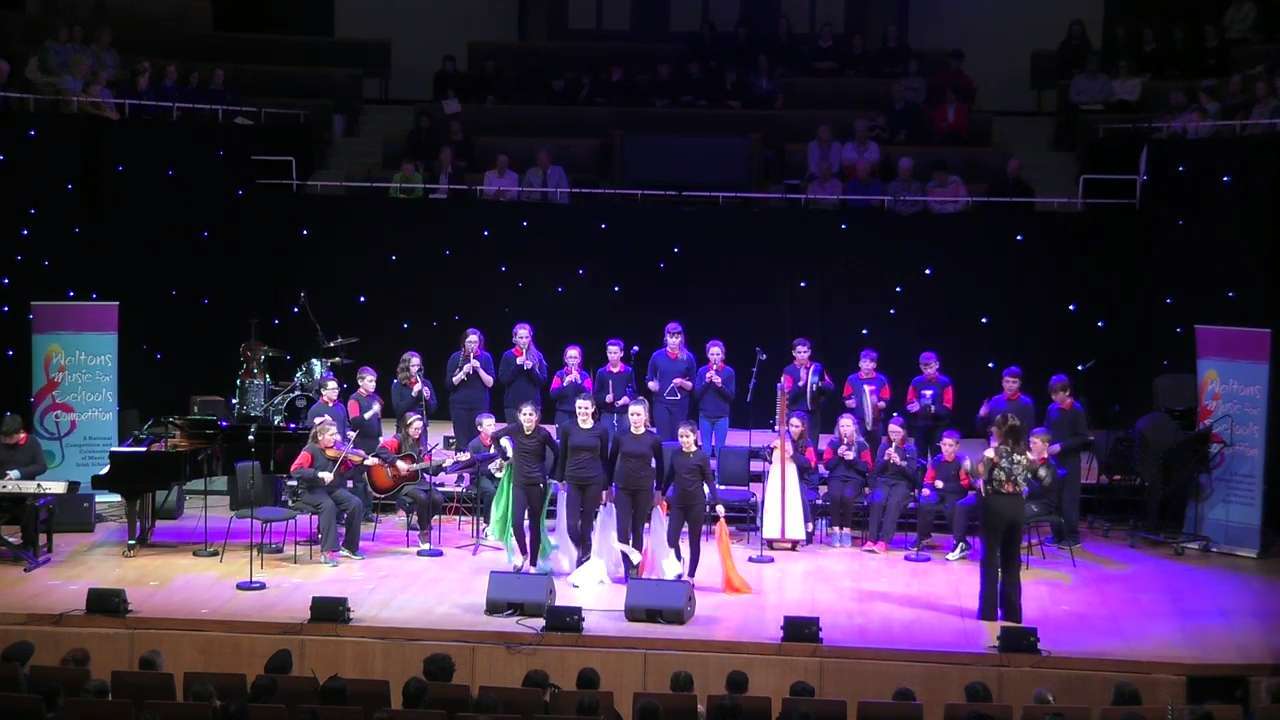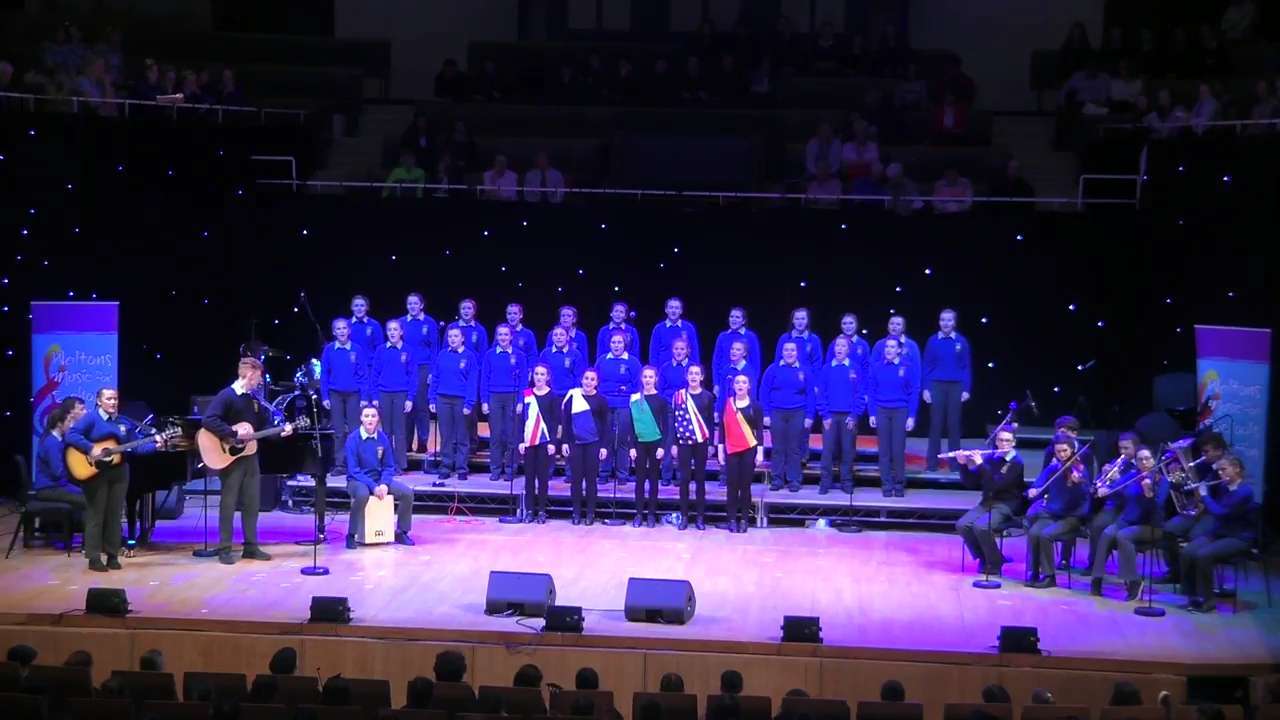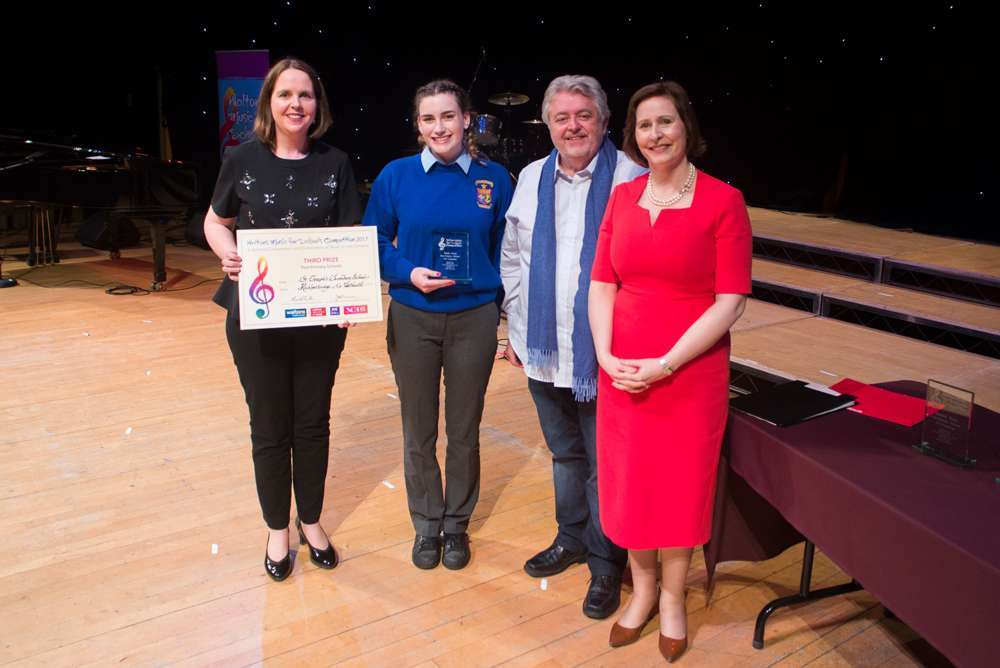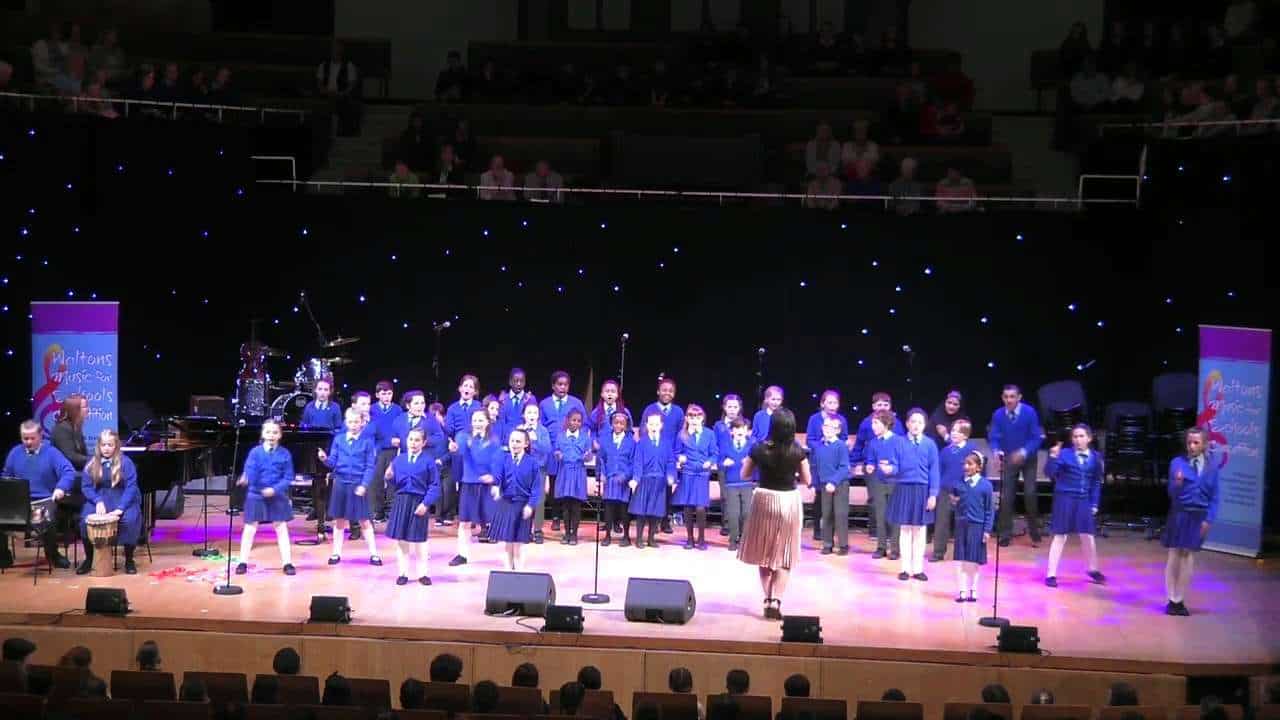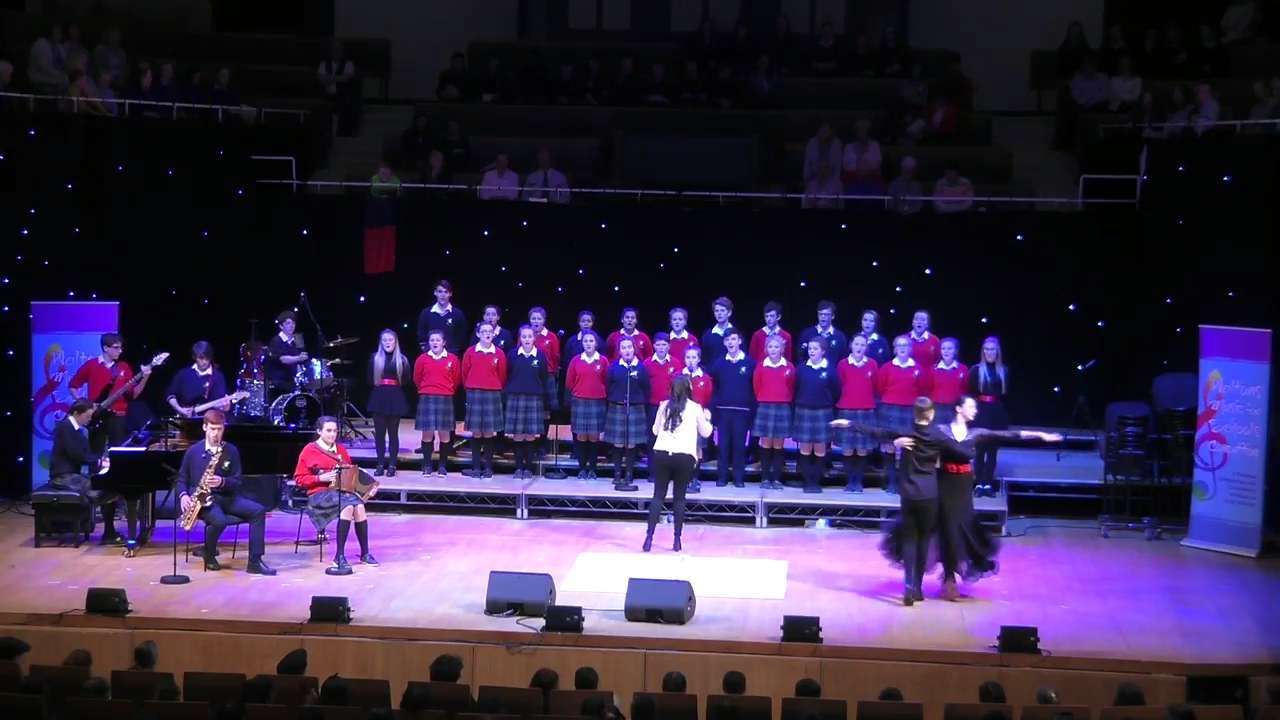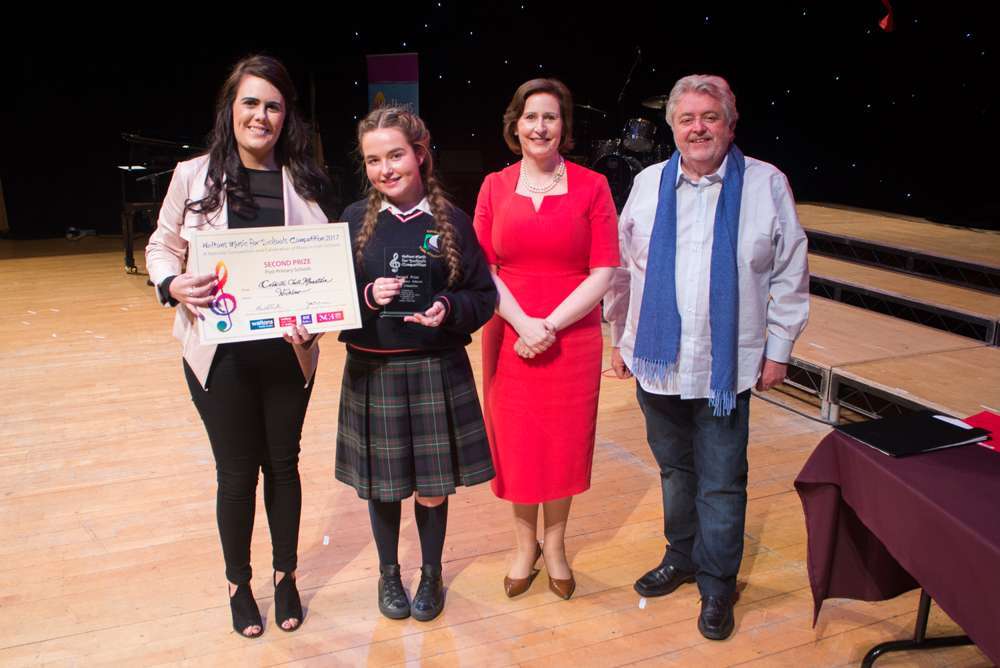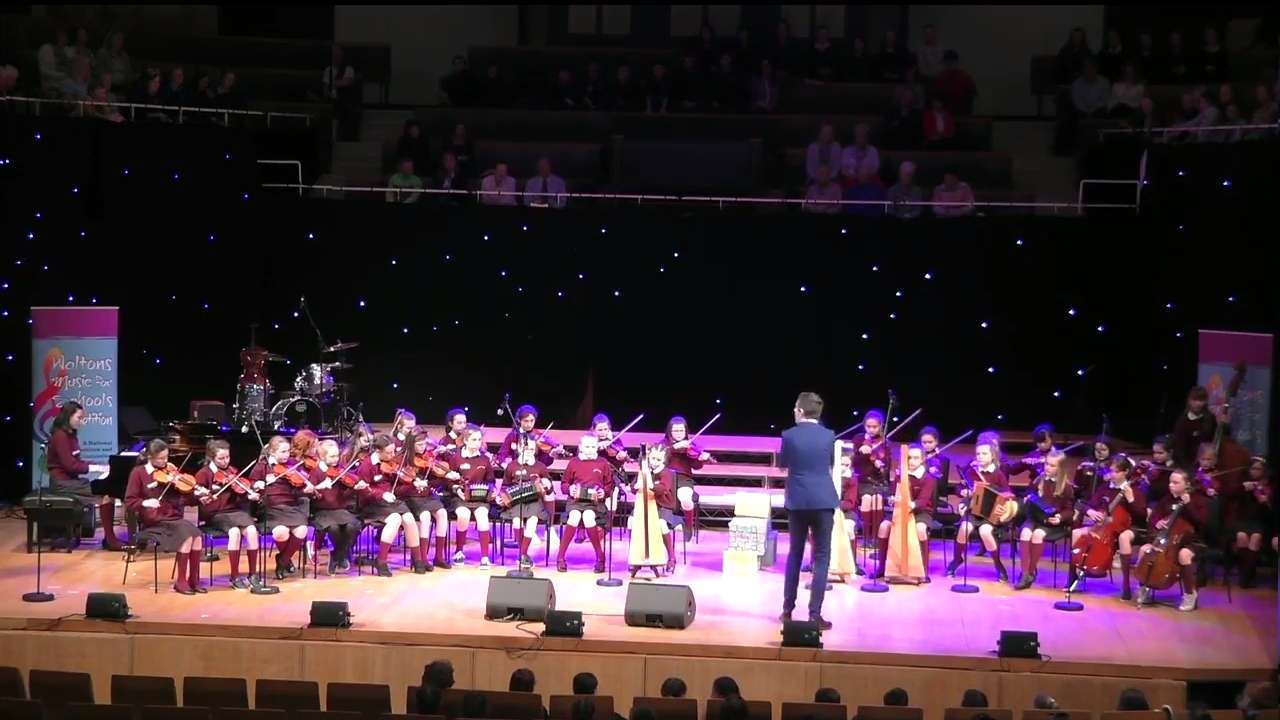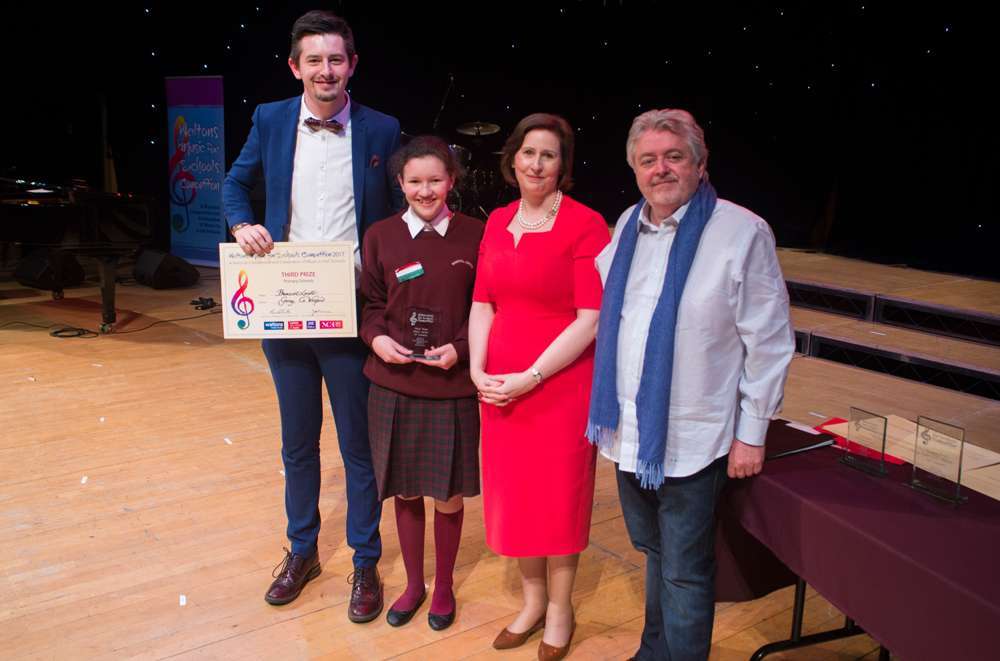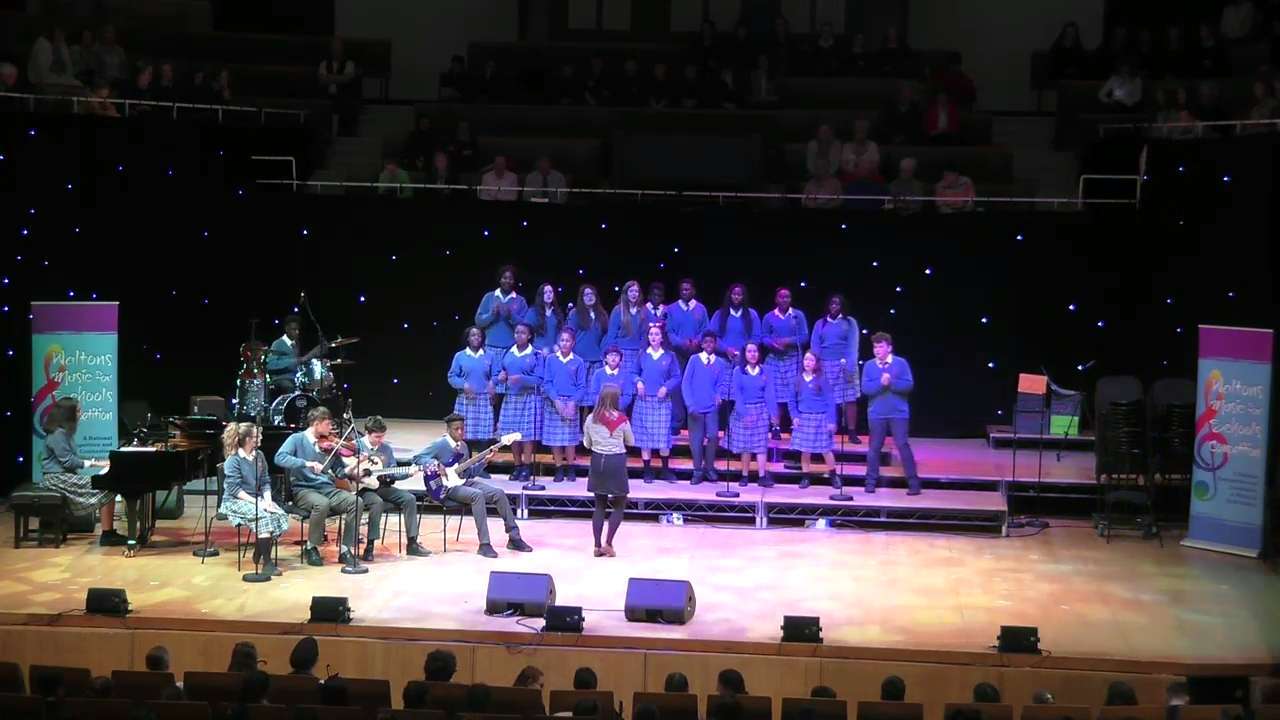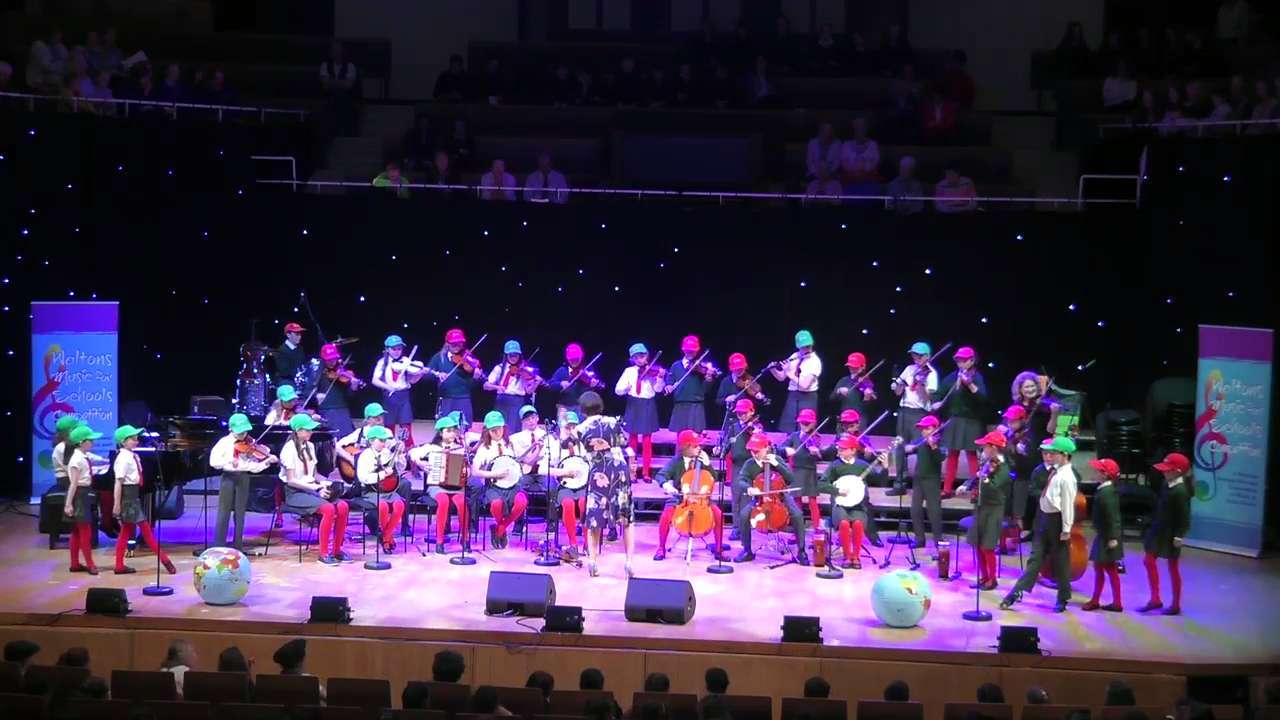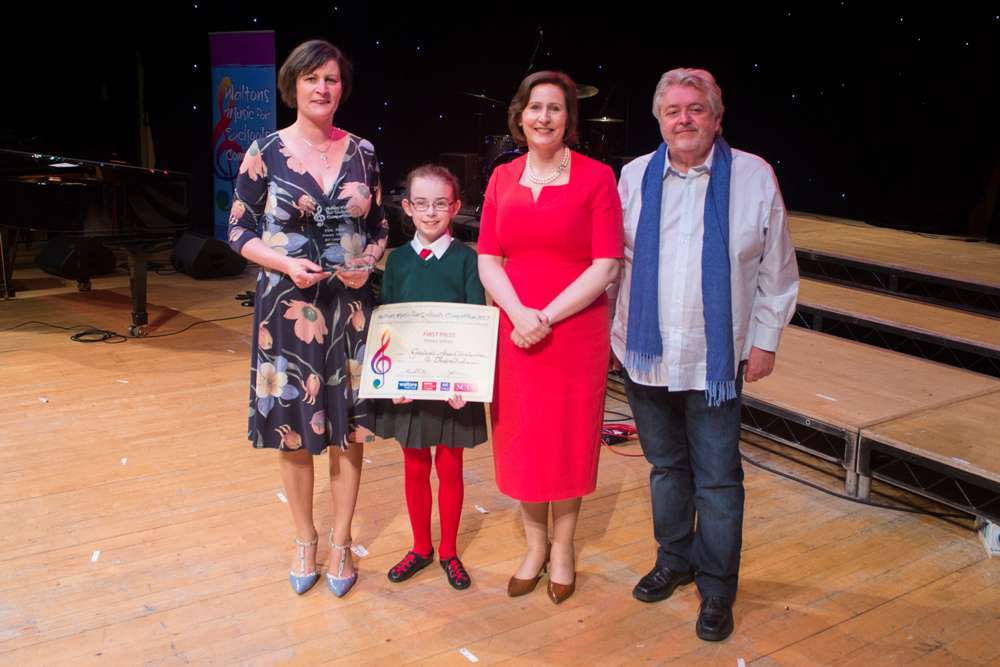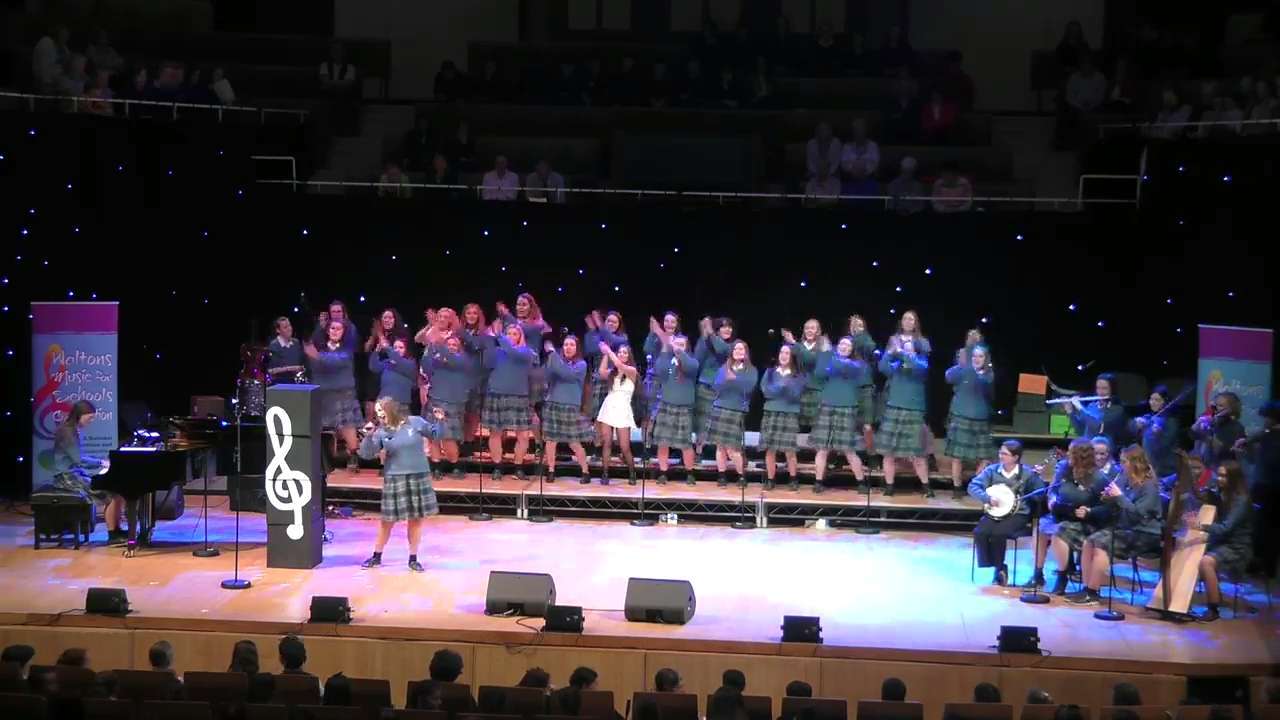2017 Waltons Music
for Schools Competition
A National Competition and Celebration
of Music in Irish Schools
This page includes:
- Entry videos and information about the twelve Finalist schools selected for the 2017 Competition.
- Lists of Commended and Highly Commended schools.
- Videos of the Finalists Concert on 2 May 2017 in the National Concert Hall.
- A list of the prize-winning schools.
- Two galleries, the first of the Finalist groups in rehearsal and the second of the groups in performance as well as prize presentations.
Primary School Finalists
The six Primary School Finalists, as well as Highly Commended and Commended schools, selected in the 2017 Waltons Music for Schools Competition. Schools are listed in alphabetical order, and Finalist school entry videos, profiles and how they addressed the 2017 Competition theme, Music Has No Borders, are below these.
Finalists
- Bunscoil Loreto, Gorey, Co. Wexford – Orchestra Entry
- Carnaross National School, Kells, Co. Meath
- Gaelscoil Adhamhnáin, Leitir Ceanainn, Co. Dhύn Na nGall
- Gaelscoil Aonach Urmhumhan, Co. Thiobraid Árann
- Scoil Chaitríona Senior, Renmore, Co. Galway
- St. John's National School, Breaffy, Co. Mayo
Highly Commended
- Corville National School, Roscrea, Co. Tipperary
- Danecastle National School, Carrig on Bannow, Co. Wexford
- Donaghpatrick National School, Tuam, Co. Galway
- Gaelscoil Moshíológ, Guaire, Co. Loch Garman
- Gaelscoil Shlí Dála, An Bealach Mór, Co. Laoise
- Loreto Senior Primary School, Crumlin Road, Dublin 12
- Presentation Primary School, Fermoy, Co. Cork
- Scoil Bhríde, Mionloch, Co. Gaillimh – Rang 3 & 4 Entry
- Scoil Na Mainistreach Quin Dangan, Quin, Co. Clare
- Scoil Nioclais Naofa, Dunlavin, Co. Wicklow
- St. Joseph's Girls National School, Clonakilty, Co. Cork
Commended
- Ballymacarbry Central National School, Ballymacarbry, Co. Waterford
- Bunscoil Loreto, Gorey, Co. Wexford – All Other Entries
- Bishop Galvin Central School, Newcestown, Co. Cork
- Caragh National School, Caragh, Co. Kildare
- Gaelscoil Chionn tSáile, Chionn tSáile, Co. Corcaigh
- Gaelscoil de hÍde, Oranmore, Co. na Gaillimhe
- Lissenhall National School, Nenagh, Tipperary
- Monaleen National School, Castletroy, Limerick
- Our Lady of Good Counsel GNS, Dun Laoghaire, Co. Dublin
- Our Lady's Clonskeagh, Milltown, Dublin 14
- Scoil Bhríde, Mionloch, Co. Gaillimh – Rang 5 & 6 Entry
- Scoil Mhuire Convent Primary School, Ardnanagh, Co. Roscommon
- St. Ciaran's National School, Baylin, Co. Westmeath
- St. Ciaran's National School, Hartstown, Dublin 15
- St. Joseph's Primary School, Ballinrobe, Co. Mayo
Bunscoil Loreto
Gorey, Co. Wexford
Entry
Title 'Musical Journey'
Group Bunscoil Loreto Orchestra • 40 members, Senior Infants – Sixth Class
• Niall Quillinan, Conductor
About the School
Bunscoil Loreto (696 students) has a thriving whole‐school music programme in which children, teachers and parents are involved. Such was the interest in this year’s Competition that many more students wanted to be involved than could be accommodated with a single entry, so the school submitted no less than nine entries, starting with a group of Junior Infants! All students in Bunscoil Loreto learn tin whistle from Junior Infants to Sixth Class through a special curriculum developed by the school, and violin is also taught to all students from Second to Fifth Class. In addition to instrumental teaching, the school has several choirs, a school orchestra, a school traditional group and a harp ensemble. There is also a staff choir and traditional group, and teachers at Bunscoil Loreto are not only very involved in the school’s music programme but also in the wider community. Finally, in association with the Gorey/Ballygarrett branch of Comhaltas Ceoltoirí Éireann, the school hosts group practice sessions every week. Bunscoil Loreto planned to use a Music for Schools Competition prize for more instruments, including violas, concertinas, button accordions and possibly a harp.
Addressing the Theme
Having brainstormed many ideas to illustrate this year’s theme, the group developed a storyline that was current and relevant to their town. The piece begins in rural Hungary. The group plays the slow section of Vittorio Monti’s Csárdás to set the scene in which a young couple with their baby leave their family and friends in search of a better life. They journey to Ireland across land and sea borders. The music changes to ‘Raglan Road’ as the couple settle into Ireland and learn the traditions and customs of the country. Later the couple take a trip home with their daughter now grown into a little girl, and ‘Raglan Road’ has also gone through quite the transformation. As the family are reunited, they share stories and admire their granddaughter. Music is the background to the lives of these people and is also the backdrop of our own lives. It travelled with the family despite the physical borders they encountered, and music accompanied the varied emotions they felt. Music is with us in times of great sorrow and in times of celebration, as music has no borders.
Carnaross National School
Kells, Co. Meath
Entry
Title ‘Music Makes It All Worthwhile’
Group Carnaross National School Fifth & Sixth Class Group • 30 members
• Helen Sherlock, conductor • Harry Long, guitar
About the School
In addition to curricular music, each class in Carnaross National School (152 students) has additional tuition in both tin whistle and bodhrán from a visiting teacher, and there is also weekly choir practice. A number of musical events take place each year, including monthly ‘Musical Moment’ informal concerts, in which participants from all classes perform for an audience of students and staff. Carnaross National School planned to use a Music for Schools Competition prize to introduce a new instrument, possible ukulele, in the school, as well as to purchase additional percussion instruments and possibly a sound system.
Addressing the Theme
Through individual and class brainstorming and discussion, the group decided to focus on the idea that there are no restrictions in music – fast or slow, loud or soft, high or low, unison or harmony, rock or church, happy or sad. They also identified areas – often associated with figurative and literal borders, such as races, nationalities, countries, religions and beliefs, emotions and feelings – where they felt that music would promote unity, expression, admiration, enjoyment, celebration and respect. They decided to convey their message with a range of music, starting with ‘Equinox’ (composed by their teacher Helen Sherlock), a piece that focuses on the links between paganism and Christianity in early Ireland; then ‘Críost Liom’ (St. Patrick’s Breastplate), which may have had its origins in pre-Christian Ireland; then ‘The Harmony March’ (composed by tin whistle and bodhrán teacher Harry Long), a celebration of harmony and peace between Ireland and Northern Ireland and England; and finally ‘Music Makes It All Worthwhile' by local band Ham Sandwich, changing the song’s lyrics, with the band’s permission, to express their theme.
Gaelscoil Adhamhnáin
Leitir Ceanainn, Co. Dhún na nGall
Entry
Title ‘Saol Gan Cheol, Saol Gan Anam’ (A World without Music Is a World without Soul)
Group Meitheal • 40 members, Fourth – Sixth Class
• Sinéad Uí Dhomhnaill, Teacher/Conductor
About the School
Gaelscoil Adhamhnáin (430 students) provides a wide range of extra-curricular music tuition for its students before school, after school and at lunchtime. The school’s board of management helps to finance this tuition, and the school also works with the Donegal Music Education Partnership and Ceol na Coille, a school of Irish traditional music, to provide it. Adhamhnáin offers several ensemble opportunities for its students, including a Junior Grúpa Ceoil, Senior Grúpa Ceoil, Ballad Group, Pop Group and School Choir. Whenever possible, the school provides instruments to students at no cost, and Cumann na bPíobairí in Donegal has loaned ten sets of uilleann pipes for students to learn. Gaelscoil Adhamhnáin planned to use a Music for Schools Competition prize to expand its instrument bank and provide both staff and students with additional music resources – as well as to highlight the school’s musical achievements both locally and nationally.
Addressing the Theme
Before any instruments, vocals or notation were introduced, the students were introduced and got to know each other as group members – a crucial exercise, as many of them would not ordinarily mix as friends in or outside school because of different classes, ages and social circles. The group were asked to contemplate the competition theme, look at the individual members, think of their local area, think of Donegal, think of Ireland and then think of all of these in the context of the larger world we live in. A quotation from the great American arts advocate Charles Fowler was then read: ‘The greatest gift one people can give to another is to share their culture…. To share artistic creations across cultures is to share our deepest values.’ The entry piece was developed in parts, beginning with a ‘chant’ style song entitled ‘Dún na nGall’, which the students composed with the help of their musical director. More discussion brought up the idea of Canadian geese, annual visitors to Donegal, and how freely they can come and go, so the group researched a Canadian jig and put together a dance for the tune. The group then developed the idea splitting into two and walking to a ‘border’ visualised by a divide in the groups, who sing the Proclaimer’s song ‘500 Miles’, with new lyrics (in Irish) express the children’s perspective of growing up in a multicultural society. For the next section, they researched appropriate song lyrics, poems, quotations, etc. and agreed that the lyrics of ‘From a Distance’ by the American singer-songwriter Julie Gold best expressed their vision: ‘From a distance we are instruments / Marching in a common band / Playing songs of hope, playing songs of peace / They are the songs of every man.’ For the finale, a past pupil and former Waltons Music for Schools Finalist suggested the song ‘Music’ by Madonna, which includes the significant line: ‘Music makes the people come together.’
Gaelscoil Aonach Urmhumhan
Aonach Urmhumhan, Co. Thiobraid Árann
Entry
Title ‘Ar Scáth a Chéile – United We Stand, United We Play’
Group Grúpa Ceoil na Gaelscoile • 40 members, Senior Infants – Sixth Class
• Orla McNamara, conductor • Lisa Duffy, violin
About the School
Every Second – Sixth Class student in Gaelscoil Aonach Urmhumhan (220 students) takes part in a weekly Banna Ceoil na Scoile, and the school also has a thriving Ceolfhoireann na Gaelscoile, as well as junior and senior choirs, playing and singing music of all genres. All children in the school, from Senior Infants up, learn tin whistle, and students play a wide range of instruments for the Banna Ceoil. Aonach Urmhumhan has also compiled its own school music book with Banna Ceoil pieces suitable for Junior Infants to Sixth Class, as well as a songbook entitled Canaimis le Chéile that includes traditional Irish songs, pop songs, Christmas carols and hymns. Although most student instruments are purchased by parents, the school also has a selection of percussion instruments freely available to students. Gaelscoil Aonach Urmhumhan planned to use a Music for Schools Competition prize to develop a rental scheme for instruments in order to broaden the scope of their orchestra, including violas and perhaps a double bass.
Addressing the Theme
The group brainstormed the theme in the context of an Irish language school and decided to show how music transcends languages and genres in unifying children. The piece begins with two separate groups – Irish traditional and classical – playing and singing ‘It’s a Small World’ in German, French, English and Irish. The students then come together during their version of The Beatles’ ‘I Want to Hold Your Hand’. The classical group then starts playing Pachelbel’s Canon, and the traditional group responds by playing Eileen Ivers’ ‘Canon Frolics’. The two groups then unite to play The Farm’s ‘All Together Now’ and finish with Seo Linn’s ‘Ar Scáth a Chéile’ (Working Together), which includes African lyrics.
Scoil Chaitríona Senior
Renmore, Co. Galway
Entry
Title ‘Music Has No Borders’
Group Heart of Renmore • 39 members, Third – Sixth Class
• Ciara Doyle, conductor • Teresa Turner, piano
About the School
A DEIS school, Scoil Chaitríona Senior (380 students) seeks to provide rich and diverse musical experiences for its students, both individually and collectively. The school has limited funds available from the Department of Education but stretches them to include a school choir and marching band, as well as tuition in singing, percussion, tin whistle and other instruments. Performing groups from the school have a tradition of bringing soulful performances to the public at events such as performing in Galway Hospice and the lighting of the Christmas tree in University Hospital Galway. In December 2015, the school launched ‘The Anthem of Scoil Chaitríona’, composed by choral director Anne Flaherty, with lyrics encapsulating the sense of belonging and respect for different traditions, as well as the understanding that students are making new traditions as they learn and grow together. Scoil Chaitríona does not have privately funded music lessons and planned to use a Waltons Music for Schools Competition prize to develop these and provide its students with a wider range of musical experiences.
Addressing the Theme
Scoil Chaitríona students come from a wide variety of cultural and ethnic backgrounds. It is also the only school in Connacht with a Deaf Unit for children with profound hearing Impairment. Although the children in this unit integrate with classes for many subjects, it can still be difficult for them, so the group decided to use music as a tool for integration. The songs they chose are Cyndi Lauper's ‘True Colours’, Bob Marley's ‘One Love’ and ‘World in Union’ – selected for their musical diversity as well as appropriateness to the theme. The hearing-impaired pupils and hearing-impaired SNA, along with the class teacher, taught the children to sign every word of the songs, and this became second nature to the children involved. The merging of two unique languages, music and ISL (Irish Sign Language) was a positive and empowering journey for the students.
St. John's National School
Breaffy, Co. Mayo
Entry
Title ‘Gan Teorainn’ (Without Borders)
Group Le Chéile • 37 members, Senior Infants – Sixth Class
About the School
With the aim of making children’s musical experiences as diverse and rich as possible, St. John’s (431 students) offers a range of music options for students in addition to curricular music, including tuition in fiddle, banjo, mandolin, button accordion, piano accordion, tin whistle, flute and guitar. Children are also involved in the National Children’s Choir, and they sing and play competitively in Scór and the Fleadh Cheoil. During the summer they take part in weekly Oíche Cheoil sessions with one of the teachers and other local traditional Irish musicians in Breaffy House Hotel. Children also learn such céilí dances as ‘Ballaí Luimní, Ionsaí na hÍnse’, as well as the older, traditional sean-nós dances. Contemporary music is also a popular choice, as are the musicals performed each Christmas. St. John’s planned to use a Music for Schools Competition prize to purchase a PA system so that the students can get used to setting up microphones and speakers and possibly creating trad/pop/rock band.
Addressing the Theme
A DEIS school, St. John's has many students of diverse ethnicities and cultural backgrounds attending, and the Le Chéile group is a microcosm of the school’s community – with solo vocalists from the Traveller community and Pakistan, and dancers from Lithuania and Latvia. However, all the children and teachers are very proud of the fact that Mayo is a county steeped in traditional Irish music, and they sought to build on that tradition and use the Competition as a catalyst for musical interaction and exploration. The pieces chosen include the air ‘Molly McAlpine’, followed by ‘The Foggy Dew’, telling the tale of Irish nationalism and British Imperialism. This is followed by ‘Mick Fadian’s March’, composed by Des Cafferkey from Achill Island about the legendary local piper Mick Fadian. The group then plays the lively jig ‘Amach San Fharraige’ (Out on the Ocean), reflecting their sense of place and physical landscape as a county situated on the Atlantic Ocean, followed by ‘Mawla Ya Sali Wasalim’, a traditional Arabic air about peace and love. Their entry finishes with ‘What a Wonderful World’, followed by students from different ethnic backgrounds addressing us in their native language.
Post-Primary School Finalists
The six Post-Primary School Finalists, as well as Highly Commended and Commended schools, selected in the 2017 Waltons Music for Schools Competition. Schools are listed in alphabetical order, and Finalist school entry videos, profiles and how they addressed the 2017 Competition theme, Music Has No Borders, are below these.
Finalists
- Coláiste Chill Mhantáin, Burkeen, Wicklow Town, Co. Wicklow
- Cólaiste Pobail Setanta, Clonee, Dublin 15
- Davis College, Mallow, Co. Cork
- Loreto Secondary School, Balbriggan, Co. Dublin
- Scoil Mhuire, Trim, Co. Meath
- St. Joseph's Secondary School, Rochfortbridge, Co. Westmeath
Highly Commended
- Boyne Community School, Trim, Co. Meath
- De La Salle College, Dundalk, Co. Louth
- St. Fergal's College, Rathdowney, Co. Laois
- St. Mary's Secondary School, Macroom, Co. Cork
- St. Paul's College, Raheny, Dublin 5
Commended
- Clifden Community School, Clifden, Co. Galway
- Killorglin Community College, Killorglin, Co. Kerry
- St. Brigid's College, Loughrea, Co. Galway
- St. Kevin’s Community College, Dunlavin, Co. Wicklow
Coláiste Chill Mhantáin,
Burkeen, Wicklow Town, Co. Wicklow
In addition to curricular music, Coláiste Chill Mhantáin (950 students) has offered a variety of extra-curricular music activities for its students this year, including Emmanuel 2017, a Dublin Archdiocese initiative where students from 26 schools prepare and perform 21 liturgical songs, both traditional and contemporary; a Music Generation project that provided students with the opportunity to write and perform several songs together; céilí dancing provided by Transition Year to First Year students as part of Seachtain na Gaeilge celebrations; and an Arts Week during which students participated in a range of music and arts events. Coláiste Chill Mhantáin planned to use a Music for Schools Competition prize to add more instruments to their instrument bank, as well as recording equipment and a new PA system.
Addressing the Theme
All students who expressed an interest in participating in the Competition were invited to attend a meeting to inform them of what it entailed. An Edmodo group was then created to provide a platform for the students to contribute ideas around the Competition theme, as well as to highlight their individual talents that they felt could enhance the performance, including ballroom dancing, sign language (offered as a TY module within the school) and Irish dancing. In a subsequent meeting with all participating students, the theme of LGBT was also explored. As love emerged as the dominant theme, they discussed a range of song possibilities, and Macklemore’s ‘Same Love’ struck a chord and formed the basis for their performance. Other songs selected echoed the message of this song, and since music does not discriminate in terms of gender or sexuality, all songs relating to the theme love were suitable for the performance. The students then collaborated in small groups to design and construct a wide variety of components to enhance the performance and engage the listener, like the pieces in a jigsaw puzzle. The idea that music transcends what divides us inspired the creation of their closing element, the jigsaw heart.
Entry
Title ‘Love Grows with Each Piece’
Group Coláiste Chill Mhantáin Music Ensemble • 36 members, First – Sixth Year
Cólaiste Pobail Setanta
Clonee, Dublin 15
Cólaiste Pobail Setanta (1,128 students) is situated in a disadvantaged area, and although there is a wealth of musical talent in the school (as evidenced by the Second Year instrumentalists performing in their entry) very few of its students have the opportunity to attend private music lessons, so in addition to curricular music the school offers tuition in choir, tin whistle, recorder and singing. Cólaiste Pobail Setanta planned to use a Music for Schools Competition prize to replace faulty instruments, as well as to purchase a new set of orchestral instruments.
Addressing the Theme
The group discussed possible ways to approach the theme, the current crisis in Syria and how fortunate the school is to have students of such diverse nationalities and backgrounds. Although some of the students come from ‘Half the World Away’ (Oasis), that doesn’t prevent them from working together in harmony at choir practice every Wednesday lunchtime. They then chose ‘Where Is the Love’ (The Black Eyes Peas), which continues the theme, and worked out a way to merge the two songs through the musical arrangements of some very talented students.
Entry
Title ‘Half the World Away / Where Is the Love?’
Group Setanta Choir • 27 members First – Third Year choristers, Second Year instrumentalists
Davis College
Mallow, Co. Cork
A DEIS school, Davis College (850 students) introduced music as a subject in 2004, funded by a grant from the School Completion Programme. It now has an active curricular and extracurricular music programme, and a number of its students have gone on to third-level music study at University College Cork and the CIT Cork School of Music. In addition to having a choir and Irish traditional music group, Davis offers after-school lessons in a range of instruments in association with the County Cork School of Music. While music is well served at the school, with various events throughout the year, Davis would like to develop a larger instrumental ensemble as well as an instrument rental scheme for its many talented students who can’t afford instruments. Davis planned to use a Music for Schools Competition prize to acquire instruments for the rental scheme, as well as amps and microphones for their music room.
Addressing the Theme
Davis held brainstorming sessions with different year groups, with the question ‘What does music has no borders actually mean?’ and then ‘how would you convey ‘music has no borders?’ using all the talents available in the school – vocal, instrumental and dance. The students developed the idea of representing the school’s diverse and multicultural community by fusing different genres, eras, languages and dance. Such was the interest in this project that auditions had to be held, and the final group included members who had never participated in music activities before. After much debate and discussion, their entry piece was built from four pieces selected and adapted by the students: Patrick Cassidy’s ‘Mise Éire’, David Guetta’s ‘Titanium’, ‘Humours of Tulla’ (a reel) and Shaun Davey’s ‘May We Never Have to Say Goodbye’.
Entry
Title ‘In-Sync’
Group Davis College Choir & Traditional Group • 39 members, First – Sixth Year
Loreto Secondary School
Balbriggan, Co. Dublin
Loreto Secondary School (1,240 students) offers curricular music to Leaving Cert. level as well as junior and senior choirs, an orchestra, a traditional group and a ukulele lunchtime group that are all free to students. Teachers regularly give up their lunchtimes and stay after school to facilitate musical activities. Transition Year students produce an annual musical and study samba in a six-week module. Private piano tuition is also offered after school. The school hosts three ‘Ceol Loreto’ concerts each year, and all students are encouraged to participate, either in groups or individually. Loreto planned to use a Music for Schools Competition prize for an instrument bank to encourage participation by many students in the school who cannot afford instruments.
Addressing the Theme
The project began with the group getting together to discuss the various ‘borders’ in our lives. At first they spoke about borders between countries and differences of cultures, languages, etc. – but after further discussion they decided to address the ‘social’ borders that affect so many people today. They researched songs and music that touched on four issues – Freedom, Solidarity, Equality and Justice – and decided in the end on four songs that expressed these: Michael Jackson’s ‘We Are the World’ (Solidarity and Justice), Macklemore’s ‘Same Love’ (Equality), The Heathers’ ‘Forget Me Knots’ (Solidarity) and ‘Drive It Like You Stole It’ from the film Sing Street(Freedom). To further articulate their feelings, the students decided to include a spoken word element that addressed these concepts. Finally, they wanted the lyrics and music to stand alone in portraying their feelings, so they kept their arrangements spare and instead of traditional instruments used a number of extended techniques, body percussion and improvisation – thus embodying, even in their musical process, the theme of freedom and crossing the conventional idea of musical borders.
Entry
Title ‘Freedom, Solidarity, Equality, Justice’
Group Loreto Secondary School Ensemble • 40 members, First – Sixth Year
Scoil Mhuire
Trim, Co. Meath
In addition to curricular music, Scoil Mhuire (740 students) provides a wide range of music opportunities for its students, including an SATB school choir; a Transition Year choir; a traditional music group; and tin whistle, recorder, ukulele and piano tuition offered to all interested students, regardless of their financial situation. A recent initiative involves Fifth Year music students peer teaching tin whistle to small groups of junior students. Each year a student music committee works with the music teachers to fundraise and promote music-making throughout the school. And the school also actively collaborates and performs with other schools in the vicinity whenever possible. Scoil Mhuire planned to use a Music for Schools Competition Prize for equipment to record their music groups as well as additional instruments for students from disadvantaged backgrounds who wouldn’t otherwise be able to afford them.
Addressing the Theme
The group’s entry stemmed from the Positive Mental Health week that was run in the school, during which music was played over the intercom every day. The students recognised the power and influence that music can have on someone’s mental health and well-being and felt that their entry was the perfect opportunity to highlight the fact that music can break down the borders and stigma associated with mental illness – and can often convey what words cannot. Together, they compiled a list of songs and tunes – from different music genres – that represent the journey that people with mental illness have to overcome, and they built their entry from these. Their performance ends with ‘Make Me Stronger’ from musical Memphis, which also inspired the title of their entry.
Entry
Title ‘Music Makes Us Stronger’
Group Scoil Mhuire Performing Arts Group • 40 members, First – Sixth Year
St. Joseph's Secondary School
Rochfortbridge, Co. Westmeath
St. Joseph’s Secondary School (850 students) has one music class per year group, and students choose the subject after a two-week sampling period in First Year. A wide range of extracurricular music activities are also on offer to all students, including a school choir, school musicals, instrumental ensembles and competitions. So far this year the choir and instrumentalists have had the opportunity to participate in the school’s start-of-year concert, a Christmas carol service, a concert with the Irish Midlands Youth Orchestra, a choral workshop and a musical. St. Joseph’s planned to use a Music for Schools Competition Prize to obtain new instruments and a sound system for the music department.
Addressing the Theme
Meetings were held by the students to decide how to build the performance around the theme and After much discussion and negotiation about how to build a performance around the theme, the group concluded that if world leaders were exposed to music and negotiated and conversed through song, the world would be a more peaceful place – as music has no borders. Their performance begins with Gary Barlow’s ‘Sing’ – with lyrics altered slightly to better express the them. This is followed by the Black Eyed Peas’ ‘Where Is the Love’ to highlight major social issues in our world – and then several national anthems. These were followed by ‘Wavin’ Flag’, a song by Somali-Canadian artist K'naan that was also used as a World Cup anthem. After studying the lyrics, they concluded that ‘beautiful game’ could represent the game of life and ‘the champions’ could represent all those who, when exposed to music, can make positive changes in our world. Their entry closes with the poignant phrase, ‘Some words they can’t be spoken, only sung.’
Entry
Title ‘Uniting through Song’
Group St. Joseph’s Ensemble • 40 members, First – Sixth Year
Finalists Concert
Videos, in concert order, of the twelve school music groups performing in the Waltons Music for Schools Competition 2017 Finalists Concert in the National Concert Hall, 2 May 2017.
Gaelscoil Adhamhnáin
Leitir Ceanainn, Co. Dhún na nGall
Title ‘Saol Gan Cheol, Saol Gan Anam’ (A World without Music Is a World without Soul)
Group Meitheal • 40 members, Fourth – Sixth Class
• Sinéad Uí Dhomhnaill, Teacher/Conductor
Davis College
Mallow, Co. Cork
Title ‘In-Sync’
Group Davis College Choir & Traditional Group • 39 members, First – Sixth Year
St. John's National School
Breaffy, Co. Mayo
Title ‘Gan Teorainn’ (Without Borders)
Group Le Chéile • 37 members, Senior Infants – Sixth Class
Loreto Secondary School
Balbriggan, Co. Dublin
Title ‘Freedom, Solidarity, Equality, Justice’
Group Loreto Secondary School Ensemble • 40 members, First – Sixth Year
Carnaross National School
Kells, Co. Meath
Title ‘Music Makes It All Worthwhile’
Group Carnaross National School Fifth & Sixth Class Group
• Helen Sherlock, conductor • Harry Long, guitar
St. Joseph's Secondary School
Rochfortbridge, Co. Westmeath
Title ‘Uniting through Song’
Group St. Joseph’s Ensemble (First – Sixth Year)
Scoil Chaitríona Senior
Renmore, Co. Galway
Title ‘Music Has No Borders’
Group Heart of Renmore • 39 members, Third – Sixth Class
• Ciara Doyle, conductor • Teresa Turner, piano
Coláiste Chill Mhantáin
Burkeen, Wicklow Town, Co. Wicklow
Title ‘Love Grows with Each Piece’
Group Coláiste Chill Mhantáin Music Ensemble • 36 members, First – Sixth Year
Bunscoil Loreto
Gorey, Co. Wexford
Title 'Musical Journey'
Group Bunscoil Loreto Orchestra • 40 members, Senior Infants – Sixth Class
• Niall Quillinan, Conductor
Cólaiste Pobail Setanta
Clonee, Dublin 15
Title ‘Half the World Away / Where Is the Love?’
Group Setanta Choir • 27 members First – Third Year choristers, Second Year instrumentalists
Gaelscoil Aonach Urmhumhan
Aonach Urmhumhan, Co. Thiobraid Árann
Title ‘Ar Scáth a Chéile – United We Stand, United We Play’
Group Grúpa Ceoil na Gaelscoile • 40 members, Senior Infants – Sixth Class
• Orla McNamara, conductor • Lisa Duffy, violin
Scoil Mhuire
Trim, Co. Meath
Title ‘Music Makes Us Stronger’
Group Scoil Mhuire Performing Arts Group • 40 members, First – Sixth Year
Prize Winners
The six prize-winning music groups – three primary and three post-primary – selected by the 2017 Finalists Concert adjudicators Deborah Kelleher and Bill Whelan.
Primary Schools
First Prize
Gaelscoil Aonach Urmhumhan, Aonach Urmhumhan, Co. Thiobraid Áran
Title ‘Ar Scáth a Chéile – United We Stand, United We Play’
Group Grúpa Ceoil na Gaelscoile
Second Prize
St. John's National School, Breaffy, Co. Mayo
Title ‘Gan Teorainn’ (Without Borders)
Group Le Chéile
Third Prize
Bunscoil Loreto, Gorey, Co. Wexford
Title ‘Musical Journey’
Group Bunscoil Loreto Orchestra
Post-Primary Schools
First Prize
Scoil Mhuire, Trim, Co. Meath
Title ‘Music Makes Us Stronger’
Group Scoil Mhuire Performing Arts Group
Second Prize
Coláiste Chill Mhantáin, Burkeen, Wicklow Town, Co. Wicklow
Title ‘Love Grows with Each Piece’
Group Coláiste Chill Mhantáin Music Ensemble
Third Prize
St. Joseph's Secondary School, Rochfortbridge, Co. Westmeath
Title ‘Uniting through Song’
Group St. Joseph’s Ensemble
A selection of photographs of the twelve school music groups rehearsing for their performances in the 2017 Finalists Concert. (All photographs by Seán Laoide-Kemp.)
Performance photos, in concert order, of the twelve school music groups performing in the 2017 Finalists Concert, as well as photos of prize presentations for the six winning schools. (All photographs by Seán Laoide-Kemp.)
